

Here at Anova, we pride ourselves in our Win / Loss Analysis work helping companies understand why they are winning and losing business and how they can be more competitive in their respective marketplaces. Although our time is mostly spent working closely with our clients and focused on our research, we also have a lot of interesting thoughts that we would love to share with the rest of the world. Hence the birth of this blog.
 This blog was written by Harriet Peabody, Senior Research Analyst.
This blog was written by Harriet Peabody, Senior Research Analyst.
Understanding why customers leave is just as important—if not more so—than understanding why they stay. Churn interviews are a powerful component of Voice of the Customer (VoC) analysis, giving businesses a direct line into the motivations, frustrations, and unmet needs that drive customer departure.
But conducting these interviews effectively is an art and a science. Done well, churn interviews can uncover goldmines of insight to fuel product improvements, retention strategies, and stronger customer relationships. Done poorly, they risk sounding like post-mortems or half-hearted attempts to win back goodwill.
 Building and Leveraging Your Network: The Power of Trust and Brand
Building and Leveraging Your Network: The Power of Trust and Brand
Your network isn’t just a list of connections—it’s a critical driver of business growth. In every industry, success depends on how well you cultivate relationships, establish trust, and position your brand. But trust and brand don’t operate the same way in every market.
In mature industries, trust built over time plays a key role in decision-making, while in fast-moving, innovation-driven markets, brand credibility and cutting-edge solutions take priority. Understanding these nuances allows businesses to accelerate growth, close deals more effectively, and strengthen long-term customer relationships.
To maximize your network’s impact, you need a strategy that not only builds connections but also leverages them for real business outcomes.
 For sales leaders, success is not just about hitting quotas – it is about understanding why you are winning or losing deals. In today’s hyper-competitive market, the ability to analyze external factors such as competitor moves, customer preferences, and shifting market dynamics is what separates high-performing sales teams from the rest.
For sales leaders, success is not just about hitting quotas – it is about understanding why you are winning or losing deals. In today’s hyper-competitive market, the ability to analyze external factors such as competitor moves, customer preferences, and shifting market dynamics is what separates high-performing sales teams from the rest.
Businesses today have great internal visibility – into their Pipelines, CRM data, internal performance metrics and roadmaps but many are flying blind when it comes to understanding and acting on what’s happening externally – with competitors, customers, and partners – most companies are radically underinvested.
Competitive Intelligence (CI) and Market Intelligence (MI) give sales teams the insights they need to sharpen their strategies, stand out from competitors, and improve close rates. So, how do you gather and use this intelligence effectively?
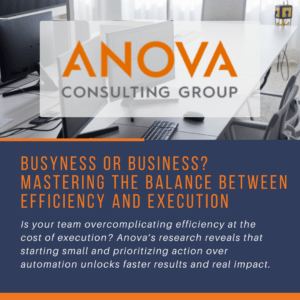 Accountability is the cornerstone of our team’s values, and we pride ourselves on delivering what we promise, when we promise. To ensure every team member embodies this value, we actively seek feedback from our own clients on their degree of satisfaction with Anova’s performance. Our year-end employee evaluations are tied to client satisfaction and program success. Despite consistently ranking in the top-performing quadrant, our team often faces challenges in one area: deal flow (defined as the number of new business contacts clients provide for win/loss phone interviews).
Accountability is the cornerstone of our team’s values, and we pride ourselves on delivering what we promise, when we promise. To ensure every team member embodies this value, we actively seek feedback from our own clients on their degree of satisfaction with Anova’s performance. Our year-end employee evaluations are tied to client satisfaction and program success. Despite consistently ranking in the top-performing quadrant, our team often faces challenges in one area: deal flow (defined as the number of new business contacts clients provide for win/loss phone interviews).
In today’s data-driven world, with the rise of advanced CRM software and generative AI, customer data seems abundant. As a result, clients often express confidence in their ability to provide customer contact information during our initial discussions. However, Anova’s experience with leading B2B companies tells a different story.
 To create and launch any successful product, you must understand the needs of your target customer. And to understand the needs of your target customer, you have to speak to them.
To create and launch any successful product, you must understand the needs of your target customer. And to understand the needs of your target customer, you have to speak to them.
Market research, particularly voice-of-the-customer market research such as win / loss analysis, offers a structured approach to understanding customer needs, competition, and product performance, helping ensure the product meets market demands and stands out in a competitive landscape.
The Role of Market Research in Ideation
Market research plays a crucial role in shaping a product idea before development begins. Through methods like surveys, interviews, focus groups, and secondary data analysis, companies can gather information about the target audience’s needs, pain points, and behaviors. This step allows businesses to validate their ideas, ensuring that the product will solve a relevant problem and have a clear market opportunity.
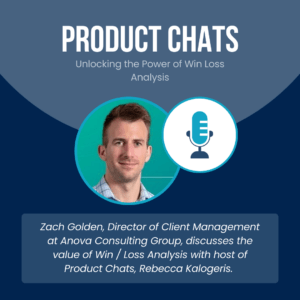 Zach Golden is the Director of Client Management at Anova
Zach Golden is the Director of Client Management at Anova
The podcast episode with Zach Golden, “Unlocking the Power of Win-Loss Analysis in Product Management,” delves into how win-loss analysis enhances product decision-making.
Golden explains strategies for product teams to leverage feedback from lost deals, the benefits of understanding competitive positioning, and ways to align product features with market needs.
He also highlights the importance of collaboration between product, sales, and marketing to refine customer value propositions and maintain a competitive edge.
For full insights, you can view the podcast here.
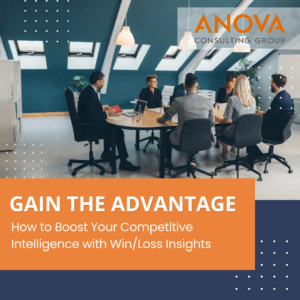 Comparison is the thief of joy…
Comparison is the thief of joy…
…unless you’re running a business.
Competitive intelligence is a vital part of running and growing a business, particularly in today’s complex B2B sales environment. While there are many ways to gather it, one often overlooked method is Win / Loss analysis. This involves interviewing clients you’ve won and prospects you’ve lost to understand why they chose—or didn’t choose—to work with you. In doing so, this research also gathers valuable insights into why these prospects did or did not go into business with your competitor.
 Keeping a plant alive seems simple: water it, give it sunlight, and watch it grow. But whether you are a hobby gardener just starting out or an experienced horticulturalist trying something new, the reality can often be different. The leaves start browning, stems wilt, and before you know it, you’re left with a pot of withered remains. The problem? Most of us are left guessing what went wrong.
Keeping a plant alive seems simple: water it, give it sunlight, and watch it grow. But whether you are a hobby gardener just starting out or an experienced horticulturalist trying something new, the reality can often be different. The leaves start browning, stems wilt, and before you know it, you’re left with a pot of withered remains. The problem? Most of us are left guessing what went wrong.
Much like a fledgling plant enthusiast trying to keep their potted basil plant alive, businesses often struggle with client retention. When a customer leaves, the natural reaction is to ask, “Why?” Without clear feedback, you’re left with a mix of generic advice: “Maybe you’re offering too little value,” “Maybe your product needs more features,” or “Perhaps the customer service isn’t up to par.” These are all valid points, but none provide specific answers tailored to your business. This begs the question, what can we do to get clearer answers and take effective action? How can we learn the right way to cultivate our basil plants (and customers) to ensure they are thriving, not dying?
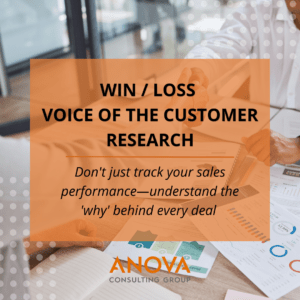 This blog was written by Bredon Attridge, Engagement Manager at Anova.
This blog was written by Bredon Attridge, Engagement Manager at Anova.
The Hidden Power in Win / Loss Research
You’ve meticulously crafted your sales strategy, honed your team’s skills, and implemented the latest CRM technology. The problem? Your competition has followed the same playbook. So, how do you take your sales approach to the next level? How can you give your team the edge over the competition?
The answers lie in a powerful, yet often ignored, approach: Win / Loss Voice-of-the-Customer (VoC) research. Currently, less than 30% of companies include this uniquely insightful program as part of their sales process. By systematically capturing candid feedback from both your winning and losing deals, you gain invaluable insights into the factors that differentiate success from defeat.
 This blog was written by Brian McMahon, a Consultant at Anova.
This blog was written by Brian McMahon, a Consultant at Anova.
Client Satisfaction Ratings, Net Promoter Scores, and Customer Listening Programs – companies employ many strategies to understand the perceptions of their client base and boost client retention. A key strategy that often goes underutilized in this pursuit is a comprehensive win/loss program. This program, focused on analyzing why deals are won or lost, can be a goldmine of insights for organizations looking to strengthen their client relationships and improve retention rates. Let’s delve into how a win/loss program can be a game-changer in client retention:
Illuminate Your Competitive Advantages and Disadvantages
A win/loss program acts as a spotlight on your organization’s strengths and weaknesses in the eyes of clients. By dissecting why you win deals, you uncover your key competitive advantages, be it product superiority, pricing strategies, or exceptional customer service.
Collin Stewart from Predictable Revenue interviews Zach Golden, Director of Client Management at Anova Consulting Group, to explore the value of win / loss analysis in sales. Despite its significant potential to boost revenue—up to 50% according to Gartner—win-loss analysis is underutilized by most companies. Zach explains how this analysis provides critical insights into why deals are won or lost, helping companies refine their sales strategies and better understand customer needs.
from Predictable Revenue interviews Zach Golden, Director of Client Management at Anova Consulting Group, to explore the value of win / loss analysis in sales. Despite its significant potential to boost revenue—up to 50% according to Gartner—win-loss analysis is underutilized by most companies. Zach explains how this analysis provides critical insights into why deals are won or lost, helping companies refine their sales strategies and better understand customer needs.
Effective win-loss analysis involves careful timing, unbiased feedback collection, and continuous iteration. While technology can assist with data processing, the human element remains crucial for gaining deeper insights through empathy and shared experiences. Ultimately, win / loss analysis is a strategic tool that can drive business growth, enhance customer-centricity, and provide a competitive edge. By embracing win / loss, companies can unlock valuable insights that drive growth and outsmart the competition.
The podcast is available on the Predictable Revenue website as well as on Youtube.
T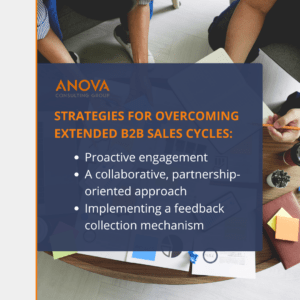 his blog was written by Brian McMahon, Consultant at Anova.
his blog was written by Brian McMahon, Consultant at Anova.
It’s not just you. Anyone involved in B2B sales over the past couple of years has experienced the frustration of deals that simply never seem to close.
Sales cycles are certainly lengthening, and the data backs it up. Below are just some of the statistics that demonstrate this unfortunate shift in how buying decisions are being made.
Purchase Process Stalls: According to Forrester, nearly 90% of global B2B buyers indicated a purchase process stall in 2023, underscoring the complexities and delays inherent in today’s sales environments.
Deal Stagnation: In 2023, approximately 60% of deals ended up in no decision, highlighting the growing trend of prolonged decision-making processes and the hurdles faced by sales teams in closing deals.
 This blog was written by Harriet Peabody, Research Analyst at Anova.
This blog was written by Harriet Peabody, Research Analyst at Anova.
There are several advantages to using a third-party for your win/loss program compared to running it in-house:
Increased Objectivity and Candid Feedback
Reduced Bias: A key benefit is reduced bias. Customers may be hesitant to give completely honest feedback to your own sales team, fearing it might hurt their chances in future deals or damage relationships. A neutral third-party interviewer can create a safe space for customers to provide frank and open feedback.Using a third-party also allows for confidentiality, should the respondent wish for it, meaning you can still receive honest feedback from those who would be unwilling to provide it without anonymity.
 This blog was written by Harriet Peabody, Research Analyst at Anova.
This blog was written by Harriet Peabody, Research Analyst at Anova.
A successful win / loss program offers a wealth of benefits for businesses by providing valuable insights into customer behavior and overall sales effectiveness and can help businesses to continuously improve in order to stay competitive. However, if a win / loss program is not executed or utilized correctly, this limits the advantages one can gain from it. Whether you are using a home-grown win / loss solution or running the program through a third party, there are certain best practices which will help you take full advantage of the benefits win / loss can offer.
In our experience here at Anova, one of the biggest hindrances to program success is at the deal-flow level. The most important thing for program success is having sample to work with.
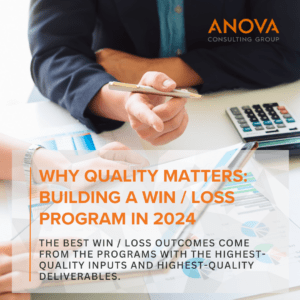 This blog was written by Andrew Cloutier, Partner at Anova.
This blog was written by Andrew Cloutier, Partner at Anova.
If It Sounds Too Good to Be True, It Probably Is. In general, teams are being asked to do more with less, both in terms of budget and FTEs. As such, the automation of processes is an important consideration in terms of cost and time savings.
The rise of automation and generative AI has created exciting opportunities across industries, including win / loss. While the potential of AI is undeniable, it’s important to approach it with a realistic mindset. An advanced AI model, no matter how sophisticated, cannot compensate for flawed data sources or poorly designed processes.
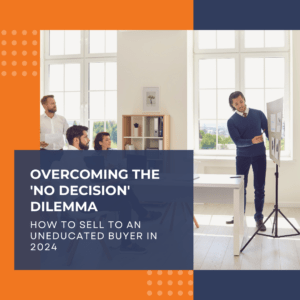 This blog was written by Zach Golden, Director of Client Management at Anova.
This blog was written by Zach Golden, Director of Client Management at Anova.
“The single biggest challenge of selling today is not selling, it is actually our customers’ struggle to buy.”
That quote from Gartner probably sums up a lot of what B2B sales teams are currently feeling.
Sales leaders that Anova talks to are constantly scratching their heads over an increasingly frustrating phenomenon: the no decision.
Why is that? What is causing more sales processes to stall? The list is long, but a few key factors are…
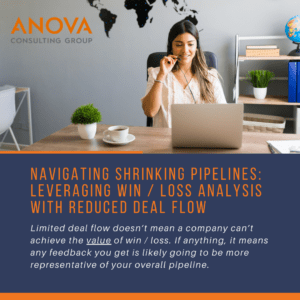 This blog was written by Zach Golden, Director of Client Management at Anova.
This blog was written by Zach Golden, Director of Client Management at Anova.
At the foundation of any win / loss program is the raw input: deals.
When deal volume declines, though, it poses critical challenges to the success of any win / loss program. The chief risks are limited analytic capabilities and challenges in trend identification as small sample sizes make it harder to distinguish between actual trends and random occurrences.
However, for companies who still want to commit to the values of having an ongoing win / loss program, there are ways to maximize the value of feedback, even if the number of deals in your pipeline seems to be on a more limited scale.
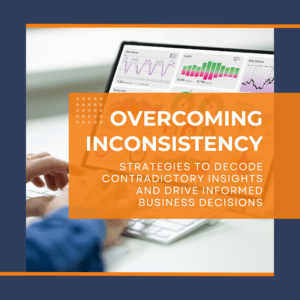 This blog was written by Zach Golden, Director of Client Management at Anova.
This blog was written by Zach Golden, Director of Client Management at Anova.
Stop me if you’ve experienced this before: you’re looking at data to help inform a business decision, but the data seems contradictory.
Perhaps it should be stop me if you haven’t experienced this, because it’s likely you have. Collect enough data points about anything and it’s likely you will find at least two that contradict one another.
Win / loss data is no different. It’s common that companies with win / loss programs have to pause to scratch their head when they start to review findings:
Our solution’s ease of use is being cited as both a strength and a weakness?
Our sales performance is a factor when we win but also when we lose?
Our pricing is competitive but also a reason why we are losing?
 This blog was written by Zach Golden, Director of Client Management at Anova.
This blog was written by Zach Golden, Director of Client Management at Anova.
In a recent Spotio study on B2B buying decisions in 2023, a staggering revelation emerged: “B2B buyers are 57%-70% through buying research before contacting sales”.
This statistic underscores the significant impact of pre-existing biases that most inbound prospects carry when engaging with sales teams. These biases encompass perceptions about your product, your company, competitor offerings, and ultimately which solution they will likely end up choosing.
On the one hand, this can work to a sales teams’ advantage if the prospect has determined their solution to be the early favorite. But even still, there appears to be much out of a salesperson’s control in B2B sales.
 This blog was written by Brian McMahon, Consultant at Anova.
This blog was written by Brian McMahon, Consultant at Anova.
In a year marked by positive economic indicators, including steady stock market gains, a low unemployment rate, and a drop in inflation, one would expect optimism to permeate boardrooms and executive offices. However, a surprising trend emerges: despite these positive signs, a notable pessimism persists among consumers, businesses, and executives regarding the economic outlook. This skepticism is underscored by the findings of the “Measure of CEO Confidence” study, conducted by the Conference Board in late 2023, revealing that 47% of CEOs anticipate a decline in economic conditions over the next six months—a notable increase from 39% in the previous quarter. Moreover, a staggering 72% of CEOs are preparing for a potential U.S. recession within the next 12-18 months.
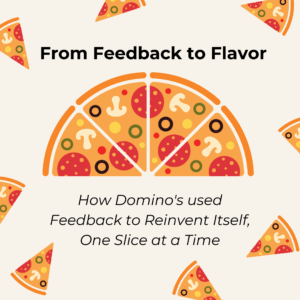 This blog was written by Brian McMahon, Consultant at Anova.
This blog was written by Brian McMahon, Consultant at Anova.
In 2009, Dominos underwent one of the most famous and successful ad campaigns in the 21st century. But it wasn’t just an ad campaign; it was a transformation of their very identity. Dominos looked in the mirror, saw they needed to change, and acted on it. The subsequent years of growth and success were a direct result of this initiative.
For those of you who don’t remember, in the years leading up to this change, Dominos was not exactly lauded as a provider of premier cuisine. Dominos was the last resort of last resorts. Kept in business largely by intoxicated college students and desperate insomniacs, Dominos occupied a space in public opinion slightly above uncooked ramen and slightly below a plain, folded-up tortilla. The sauce tasted like ketchup, and the crust tasted like cardboard.
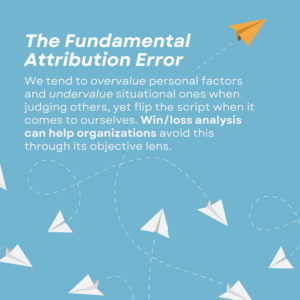 This blog was written by Harriet Peabody, Research Analyst at Anova.
This blog was written by Harriet Peabody, Research Analyst at Anova.
The fundamental attribution error is a cognitive bias that leads people to overestimate the influence of personal factors and underestimate the influence of situational factors on others’ behavior, while doing the opposite when assessing their own behavior. In other words, we attribute our own failures to the situation we were in rather than taking personal accountability due to our self-serving bias, while placing blame on others for their failures.
This bias can have a significant impact on our decision-making, both in our personal and professional lives. For example, if we win a big sale, we may attribute our success to our own superior skills and abilities. But if we lose a sale, we may blame the customer for being difficult or unreasonable. This attribution error prevents us from effectively learning from our losses and improving.
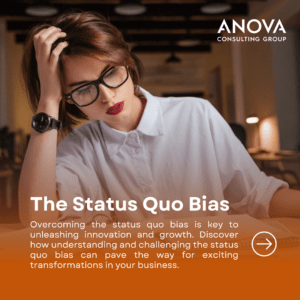 This blog was written by Harriet Peabody, Research Analyst at Anova.
This blog was written by Harriet Peabody, Research Analyst at Anova.
Status quo bias is a cognitive bias that leads people to prefer the current state and resist change. This bias can be seen in many different areas of life, from personal decision-making to organizational decision-making.
In the context of organizations, status quo bias can lead to several problems, including:
A failure to innovate. Organizations that are stuck in the status quo are less likely to develop new products and services, or adopt new ways of doing things, putting them at a competitive disadvantage.
A failure to meet customer needs. Customers’ needs and expectations are constantly changing. Organizations that don’t listen to their customers’ feedback and make changes accordingly are at risk of losing their customers to competitors.
 Given that a large majority of sales processes and presentations are now conducted virtually, with call recordings readily available, “game tape” review is an easy addition to team training efforts.
Given that a large majority of sales processes and presentations are now conducted virtually, with call recordings readily available, “game tape” review is an easy addition to team training efforts.
Watching yourself on screen or listening to your own recorded voice in the company of colleagues can be a daunting experience, but game tape sessions are invaluable. There is a lot you can learn by watching your own performance, but incorporating outside viewpoints can lead to even more fresh insights and opportunities for improvement.
While the specific approach to conducting game tape sessions may vary among organizations, here are some essential tips for facilitating them effectively.
Foster trust and openness: At the outset, emphasize that game tape sessions are designed to facilitate improvement and enhance team success. This approach will help team members feel comfortable and minimize unease.
 The Anova team is thrilled to share the results of our recent internal client satisfaction study. We’re proud to report that 92% of our clients are satisfied with our work, and 100% say we have met or exceeded their expectations. These statistics speak to our commitment to delivering high-quality services and achieving our clients’ business goals.
The Anova team is thrilled to share the results of our recent internal client satisfaction study. We’re proud to report that 92% of our clients are satisfied with our work, and 100% say we have met or exceeded their expectations. These statistics speak to our commitment to delivering high-quality services and achieving our clients’ business goals.
We help clients win.
86% of our clients say our unique approach to Win/Loss has helped them win and retain more business, and 88% say we have improved their sales effectiveness. These clients point to our direct interviews with key decision-makers as the path to gain deep insights into their markets, competitors, and customers. One satisfied client said, “The quality of Anova’s interviewing process is great. Other Win/Loss providers rely on web-based and non-personal surveys, which are much less effective. Anova’s interviews are superb.”
 Anova Consulting believes that one of the keys to success lies in the ability to adapt and learn from the challenges we face. These shared beliefs, essentially our corporate ethos, are values we strive to put into action every day. This is the final in a series of blogs that explore Anova’s values through the lens of people we feel embody them.
Anova Consulting believes that one of the keys to success lies in the ability to adapt and learn from the challenges we face. These shared beliefs, essentially our corporate ethos, are values we strive to put into action every day. This is the final in a series of blogs that explore Anova’s values through the lens of people we feel embody them.
It happens a lot: a group or team is in crisis mode. Something negative or adverse happened, and people are wondering, “Why did this happen, and who can we blame?”
Like the very best leaders and teammates, former football pro QB Tom Brady never waited to accept accountability. One game, after turning the ball over four times in a loss, Brady admitted to his teammates and fans, “That was on me. I’ve got to be better for my team, for our organization, for our fans. There are different ways to handle adversity, and my way is to take accountability for my actions.”
 Anova Consulting believes that one of the keys to success lies in the ability to adapt and learn from the challenges we face. These shared beliefs, essentially our corporate ethos, are values we strive to put into action every day. This is the sixth in a series of blogs that explore Anova’s values through the lens of people we feel embody them.
Anova Consulting believes that one of the keys to success lies in the ability to adapt and learn from the challenges we face. These shared beliefs, essentially our corporate ethos, are values we strive to put into action every day. This is the sixth in a series of blogs that explore Anova’s values through the lens of people we feel embody them.
Feedback is present in nearly every worthwhile endeavor. One great example of someone who truly embraces feedback as a gift is the multitalented Lin-Manuel Miranda. Miranda is best known as the creator of the hit musicals In the Heights and Hamilton. But his passion for telling great stories and writing great songs began long before his Broadway success. As a teenager, he would write and perform for family and friends, constantly seeking feedback and constructive criticism from anyone offering it.
In interviews, Miranda has spoken about feedback—both giving it and receiving it—as an integral part of the creative process. He once said, “Your critics are the ones who tell you what you need to hear. The praise doesn’t mean anything.”

Anova Consulting believes that one of the keys to success lies in the ability to adapt and learn from the challenges we face. These shared beliefs, essentially our corporate ethos, are values we strive to put into action every day. This is the fifth in a series of blogs that explore Anova’s values through the lens of people we feel embody them.
Craftsmanship refers to quality. It relates to workmanship. And it refers to the pursuit of excellence in execution. Antonio Lopez Garcia, a distinguished and respected Spanish painter, embodies the concept of craftsmanship through his total commitment to perfection.
Born in Tomelloso, Spain, in 1936, Lopez Garcia is widely regarded as a master of realism. He is best known for producing beautifully detailed paintings that capture the essence of everyday Spanish life, from the moody streets of Madrid to the evocative landscapes of his hometown.
 Anova Consulting believes that one of the keys to success lies in the ability to adapt and learn from the challenges we face. These shared beliefs, essentially our corporate ethos, are values we strive to put into action every day. This is the fourth in a series of blogs that explore Anova’s values through the lens of people we feel embody them.
Anova Consulting believes that one of the keys to success lies in the ability to adapt and learn from the challenges we face. These shared beliefs, essentially our corporate ethos, are values we strive to put into action every day. This is the fourth in a series of blogs that explore Anova’s values through the lens of people we feel embody them.
Cultivating a strong company culture is critically important to ensure a company’s long-term success. Warren Buffett, CEO of Berkshire Hathaway, is renowned for many things. But near the top is his firm belief in the power of a positive company culture. He has built his own company around this very principle.
At the heart of the Buffett approach is that a strong company culture begins with the idea of “good people, great team.” Building a team of talented, motivated, and ethical individuals with shared values and goals is essential to creating a positive work environment. He believes it’s vital to hire people not simply based on their skills and experience but on their cultural fit with the company.
 Anova Consulting believes that one of the keys to success lies in the ability to adapt and learn from the challenges we face. These shared beliefs, essentially our corporate ethos, are values we strive to put into action every day. This is the third in a series of blogs that explore Anova’s values through the lens of people we feel embody them.
Anova Consulting believes that one of the keys to success lies in the ability to adapt and learn from the challenges we face. These shared beliefs, essentially our corporate ethos, are values we strive to put into action every day. This is the third in a series of blogs that explore Anova’s values through the lens of people we feel embody them.
Craftsmanship, defined as the mastery of a skill through patience, discipline, and continuous improvement, is exemplified by masterful talents that spend years honing the skills required to become exceptional in their field. Julia Child, the celebrated chef who dedicated her life to perfecting the art of French cuisine, exemplified craftsmanship
Child’s passion for cooking began late in life when she moved to Paris with her husband. She enrolled in the renowned Le Cordon Bleu culinary school, where she spent years perfecting her skills in the art of French cooking.
 Anova Consulting believes that one of the keys to success lies in the ability to adapt and learn from the challenges we face. These shared beliefs, essentially our corporate ethos, are values we strive to put into action every day. This is the second in a series of blogs that explore Anova’s values through the lens of people we feel embody them.
Anova Consulting believes that one of the keys to success lies in the ability to adapt and learn from the challenges we face. These shared beliefs, essentially our corporate ethos, are values we strive to put into action every day. This is the second in a series of blogs that explore Anova’s values through the lens of people we feel embody them.
Jerry Seinfeld’s success in the comedy world can, in part, be attributed to his relentless pursuit of feedback and his commitment to using that feedback to hone his stand-up craft.
In his book Seinlanguage, Seinfeld describes how he would always carry a small notebook with him to jot down observations and ideas that he could later consider for his comedy bits. He constantly ran these ideas by fellow comedians and writers, asking for feedback on his material and delivery. The comedian viewed feedback as essential for growth and improvement, and he remained open to constructive criticism.

Anova Consulting believes that one of the keys to success lies in the ability to adapt and learn from the challenges we face. These shared beliefs, essentially our corporate ethos, are values we strive to put into action every day. This is the first in a series of blogs that explore Anova’s values through the lens of people we feel embody them.
The key to success lies in the ability to adapt and learn from the challenges we face. It requires the courage to push beyond our comfort zone and embrace adversity with a positive attitude. This approach, known as a “growth mindset,” is illustrated in the work of Carol Dweck, an acclaimed Professor of Psychology at Stanford University.
This is the fourth installment in a series of blogs discussing how sales teams win more by demonstrating value through taking a consultative approach. The previous installment explored how sales teams can be more consultative by clearly understanding prospects’ unique needs. This installment discusses a second way sales teams can be consultative. This blog was written by Yosen Wang, Analyst.
 Customize Product Demonstrations and Presentations
Customize Product Demonstrations and Presentations
It is said that communication is not the words one says, but rather what the audience understands. Once sales teams have done their homework and possess a clear understanding of prospect needs, they must communicate that understanding to their customers. In this data set, successful sales teams communicated understanding of customer needs by tailoring the content of presentations and product demos to specifically address how their solution can solve customer problems and achieve prospects’ goals.
Customization enforces a commitment to the Client and alignment with buyer search criteria.
This is the third installment in a series of blogs discussing how sales teams win more by demonstrating value through taking a consultative approach. The first two blogs established how sales teams win more by demonstrating value. Additionally, taking a consultative approach is vital to demonstrating value. This installment discusses the first of three specific ways sales teams can strive to be more consultative. This blog was written by Yosen Wang, Analyst.
 Clearly Understanding Buyer Needs
Clearly Understanding Buyer Needs
Consultative sales teams first thoroughly understand the buyers’ specific, unique needs. When Clients won, their perceived ability to understand customer needs was nearly unanimously rated as superior to the top competitor. Understanding buyer needs is the foundation for being consultative as it is the first step to tailoring messaging about how a software solution can solve for those specific needs, thereby creating value and driving wins.
Winning teams approached sales engagements with a customer-centric approach, in which helping to solve the goals of their prospect took precedence over showing off their own solution’s capabilities, some of which may not be important to the prospect’s needs.
This is the second installment in a series of blogs discussing how sales teams win more by demonstrating value through taking a consultative approach. The first blog established how sales teams win more by demonstrating value. This blog was written by Yosen Wang, Analyst.
 The Importance of a Consultative Approach
The Importance of a Consultative Approach
In order to convince prospects of the value of their solution, sales teams need to effectively assess customer needs and deliberately articulate how their solution can solve those customer needs. In other words, sales teams need to take a consultative approach.
Two pieces of data illustrate how influential a consultative approach can be in whether a sales team wins or loses:
This is the first installment in a series of blogs discussing how sales teams win more by demonstrating value through taking a consultative approach. This blog was written by Yosen Wang, Analyst.

Why do enterprise software sales teams win and lose deals? Traditional thinking would hypothesize that for high-dollar value, complex software platforms, the strength of their solution drives wins while losses are driven by a perception of higher price points and more difficult implementations, especially compared to less robust, cheaper, point solutions. Does the difference between winning and losing truly come down to price and a perception of being easy to work with? If that thinking holds true, how can enterprise software companies win despite being perceived as more expensive and more difficult to implement than their competitors?
This report explores how in enterprise software deals, winning in these competitive situations is predicated more on demonstrating value rather than absolute cost or perception of effort involved.
 This blog was written by Wayne Goodreau, Director of Client Research & Insights at Anova.
This blog was written by Wayne Goodreau, Director of Client Research & Insights at Anova.
This past weekend, my family and I saw the movie Air. Focusing on Nike’s pursuit of Michael Jordan and the birth of the Air Jordan sneaker, the film succeeded at every level. Anchored by a strong cast and a solidly paced story, it kept me engrossed the entire time, even though I already knew the outcome.
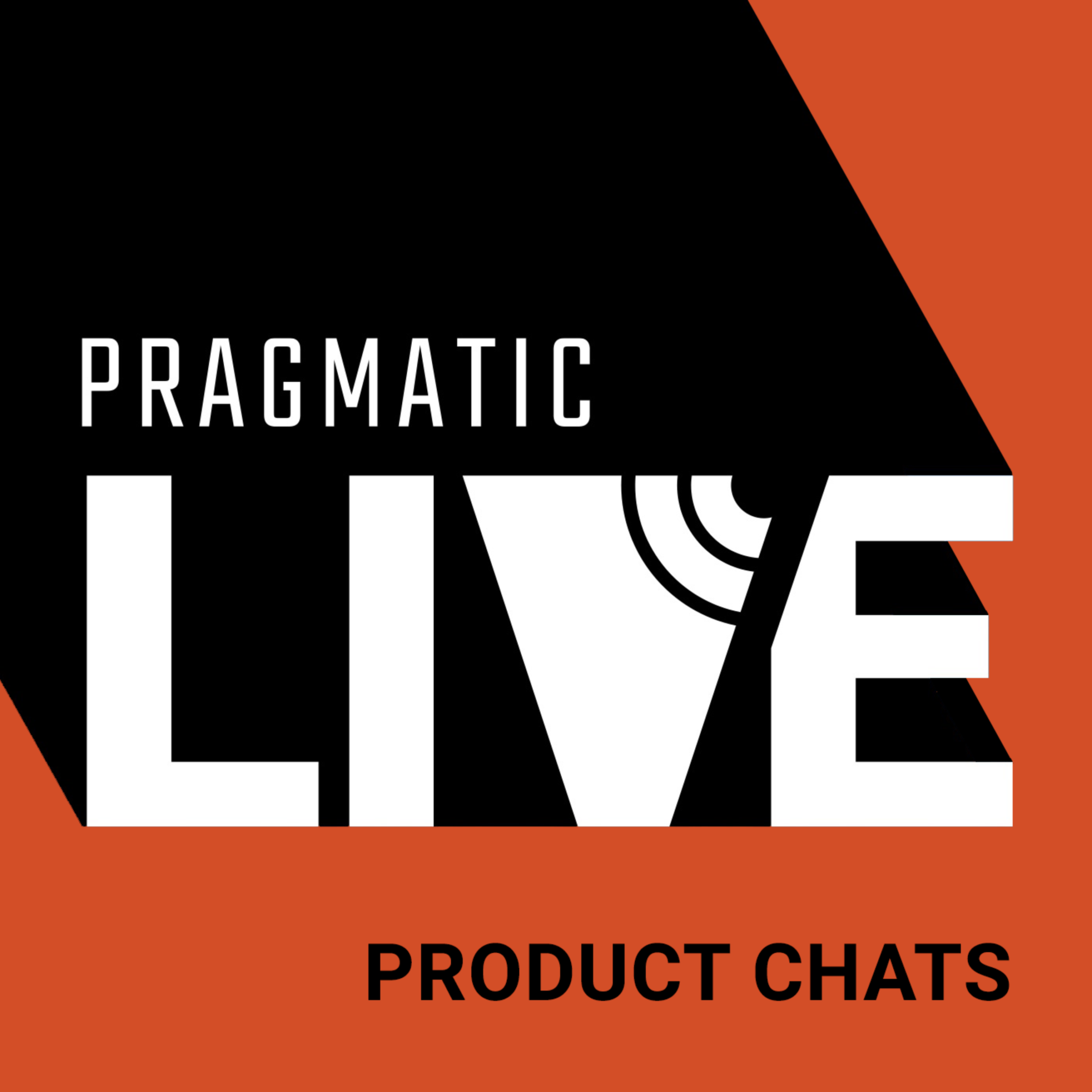
Anova’s Zach Golden and Will Young spoke with Pragmatic’s VP of Marketing Rebecca Kalogeris for Pragmatic Institute’s Product Chats Podcast to provide insights and give their perspectives on how to institute an effective Win / Loss program. Zach and Will detail their experiences with Win / Loss and the ways they have been able to help clients set up programs that align with, support, and supplement their strategic initiatives. From the initial kick-off calls to the final stakeholder presentations, Zach and Will go over each step necessary to ensure that actionable insights are revealed and that the true voice of the customer is heard. The podcast is available on the Pragmatic Marketing website as well as on Spotify.
 In a recent blog for The Pragmatic Institute, Anova Senior Research Analyst Will Young authored a blog providing information for organizations about the benefits of a win / loss program. Below is an excerpt: Knowing which of your distinctive competencies are being recognized by the marketplace allows you to adjust your marketing and sales strategies accordingly. And understanding your customers’ perspectives and what separates you from your competitors is integral to improving your win rate. To obtain this knowledge, however, you need an effective customer listening tool.
In a recent blog for The Pragmatic Institute, Anova Senior Research Analyst Will Young authored a blog providing information for organizations about the benefits of a win / loss program. Below is an excerpt: Knowing which of your distinctive competencies are being recognized by the marketplace allows you to adjust your marketing and sales strategies accordingly. And understanding your customers’ perspectives and what separates you from your competitors is integral to improving your win rate. To obtain this knowledge, however, you need an effective customer listening tool.
Win/loss programs are essential tools for capturing and understanding the voice of the customer.
When considering the importance of understanding distinctive competencies, there are two main ways a win/loss program can help:
The best win/loss programs collect a mix of both qualitative and quantitative feedback. Each of these questions elicits valuable data about how unique a company’s positioning and offerings are in the marketplace. To continue reading, click here
 Note: This blog was written by Ryan Ashe, a Research Analyst at Anova. Introduction In the same way that watching game film on an ongoing basis enables sports coaches to lead their teams to success, win/loss enables sales leaders to practice, analyze, and strategize on a regular cadence. At Anova, we find that companies that conduct win/loss on a regular basis, as opposed to merely implementing a one-off program, get the most value from the feedback. Taking advantage of a regularly scheduled win/loss program enables businesses to more effectively track changes in market perceptions over time and monitor a consistent flow of competitive intelligence. Additionally, implementing an effective win/loss program on a regular basis has the power to positively affect an organization’s culture by providing feedback that promotes stronger leadership, incentivized employees, and overall business growth. Some companies are hesitant to implement an ongoing win/loss program; but, organizations can reduce this hesitancy and reap the benefits of an ongoing program by framing negative feedback as an opportunity to grow and celebrating positive feedback. Read More about Win / Loss
Note: This blog was written by Ryan Ashe, a Research Analyst at Anova. Introduction In the same way that watching game film on an ongoing basis enables sports coaches to lead their teams to success, win/loss enables sales leaders to practice, analyze, and strategize on a regular cadence. At Anova, we find that companies that conduct win/loss on a regular basis, as opposed to merely implementing a one-off program, get the most value from the feedback. Taking advantage of a regularly scheduled win/loss program enables businesses to more effectively track changes in market perceptions over time and monitor a consistent flow of competitive intelligence. Additionally, implementing an effective win/loss program on a regular basis has the power to positively affect an organization’s culture by providing feedback that promotes stronger leadership, incentivized employees, and overall business growth. Some companies are hesitant to implement an ongoing win/loss program; but, organizations can reduce this hesitancy and reap the benefits of an ongoing program by framing negative feedback as an opportunity to grow and celebrating positive feedback. Read More about Win / Loss
 Note: This blog was written by Will Young, a Research Analyst at Anova. All win / loss programs collect data. That data can come in many different forms: internal CRM codes, feedback from internal interviews, results from web surveys, or, when done correctly, in-depth interviews with independent third-party consultants. The latter, interviews conducted by third-party consultants, is undeniably the most effective approach for collecting win / loss data. The data is gathered by seasoned interviewers and includes both qualitative and quantitative feedback about a company’s sales effectiveness, product / service offering, pricing, and overall competitiveness in the marketplace. Still regardless of the source used to collect the information, it is still just data. The true value of a win / loss program comes from unfolding the narrative behind that data. To accomplish this task, there first needs to be in-depth analysis. Strategies like rolling up the information, segmenting the findings or results, and benchmarking against relevant competitors and industry peers all help identify important themes and accentuate valuable findings. While completing the analysis is an important exercise, the overarching story that results from that analysis is what will ultimately drive change and help companies win more business. Creating the story requires experience, expertise, and the ability to identify actionable insights. Read More about Win / Loss
Note: This blog was written by Will Young, a Research Analyst at Anova. All win / loss programs collect data. That data can come in many different forms: internal CRM codes, feedback from internal interviews, results from web surveys, or, when done correctly, in-depth interviews with independent third-party consultants. The latter, interviews conducted by third-party consultants, is undeniably the most effective approach for collecting win / loss data. The data is gathered by seasoned interviewers and includes both qualitative and quantitative feedback about a company’s sales effectiveness, product / service offering, pricing, and overall competitiveness in the marketplace. Still regardless of the source used to collect the information, it is still just data. The true value of a win / loss program comes from unfolding the narrative behind that data. To accomplish this task, there first needs to be in-depth analysis. Strategies like rolling up the information, segmenting the findings or results, and benchmarking against relevant competitors and industry peers all help identify important themes and accentuate valuable findings. While completing the analysis is an important exercise, the overarching story that results from that analysis is what will ultimately drive change and help companies win more business. Creating the story requires experience, expertise, and the ability to identify actionable insights. Read More about Win / Loss
 We are excited to announce that Anova recently hired two exceptional research analysts to support our growing business. We also hired an enthusiastic and inquisitive summer intern. Ryan Ashe recently graduated from Middlebury College with a double major in economics and psychology. While at Middlebury, Ryan was a member of the varsity ice hockey team, the Sustainable Investment Club, and an Economics Research Assistant. Will Young recently graduated from Williams College with a major in economics. While at Williams, Will was the captain of the varsity cross country and track teams and a member of the Lehman Community Engagement club. Shuami Odolomerun is a rising junior at Prospect Hill Academy in Cambridge, where he is an avid basketball player. Shuami has been helping Anova with technology, operations, and client research. Read More about the Win Loss Team
We are excited to announce that Anova recently hired two exceptional research analysts to support our growing business. We also hired an enthusiastic and inquisitive summer intern. Ryan Ashe recently graduated from Middlebury College with a double major in economics and psychology. While at Middlebury, Ryan was a member of the varsity ice hockey team, the Sustainable Investment Club, and an Economics Research Assistant. Will Young recently graduated from Williams College with a major in economics. While at Williams, Will was the captain of the varsity cross country and track teams and a member of the Lehman Community Engagement club. Shuami Odolomerun is a rising junior at Prospect Hill Academy in Cambridge, where he is an avid basketball player. Shuami has been helping Anova with technology, operations, and client research. Read More about the Win Loss Team
 In previous posts we looked at how win / loss is a tool for getting 360° feedback in terms of commentary on all parts of an organization. Win / loss can also lead to a different kind of wholistic feedback: research that touches all parts of a client lifecycle. Below are examples of how companies can increase the value of their research by adding an additional feedback type, or a third leg of the stool, to their win / loss program: Post Implementation Win / loss works best in high-dollar value sales situations. When a company brings on a high revenue client, that new customer represents an even higher potential Customer Lifetime Value (CLV). The projected revenue of a new customer is not a straight-line calculation either. Each new client represents cross-sell, up-sell, and referral opportunities as well. Given the potential revenue that each new client represents, it is critically important to make sure each relationship starts off on the right foot. Read More about Win Loss
In previous posts we looked at how win / loss is a tool for getting 360° feedback in terms of commentary on all parts of an organization. Win / loss can also lead to a different kind of wholistic feedback: research that touches all parts of a client lifecycle. Below are examples of how companies can increase the value of their research by adding an additional feedback type, or a third leg of the stool, to their win / loss program: Post Implementation Win / loss works best in high-dollar value sales situations. When a company brings on a high revenue client, that new customer represents an even higher potential Customer Lifetime Value (CLV). The projected revenue of a new customer is not a straight-line calculation either. Each new client represents cross-sell, up-sell, and referral opportunities as well. Given the potential revenue that each new client represents, it is critically important to make sure each relationship starts off on the right foot. Read More about Win Loss
 Companies often reach out to Anova for guidance on starting a formal win / loss program at their organization. One of the most important things to remember for a company starting win / loss for the first time is to not rush the kickoff of a program. An airline pilot follows a thorough checklist of necessary steps and makes sure all the instruments on their dashboard are working before taking off. Similarly, it is imperative to not skip steps during the launch of a win / loss program. Once the program is “in the air”, it can be difficult to turn around and go back to do those early actions that lead to program success. Read More about Win Loss
Companies often reach out to Anova for guidance on starting a formal win / loss program at their organization. One of the most important things to remember for a company starting win / loss for the first time is to not rush the kickoff of a program. An airline pilot follows a thorough checklist of necessary steps and makes sure all the instruments on their dashboard are working before taking off. Similarly, it is imperative to not skip steps during the launch of a win / loss program. Once the program is “in the air”, it can be difficult to turn around and go back to do those early actions that lead to program success. Read More about Win Loss
 This year, people and businesses had to find ways to navigate a crisis of tremendous scope and size. B2B businesses had to make rapid changes to their workplaces and processes to adjust to this new environment. Similar to other initiatives, win / loss programs also require careful oversight to succeed during this unconventional time. Considering the unprecedented nature of the current crisis, making the right decisions for your win / loss program this year can be a daunting task. This blog is intended to help guide you in considering the impact of current circumstances on your win / loss program, and provide best practices you can utilize to ensure your program provides value for your organization during this time. Read More about Win Loss
This year, people and businesses had to find ways to navigate a crisis of tremendous scope and size. B2B businesses had to make rapid changes to their workplaces and processes to adjust to this new environment. Similar to other initiatives, win / loss programs also require careful oversight to succeed during this unconventional time. Considering the unprecedented nature of the current crisis, making the right decisions for your win / loss program this year can be a daunting task. This blog is intended to help guide you in considering the impact of current circumstances on your win / loss program, and provide best practices you can utilize to ensure your program provides value for your organization during this time. Read More about Win Loss
 As the business world grapples with COVID-19, the increase in video conferencing for internal as well as external meetings is trending. Microsoft Teams, just one of the many video conferencing platforms available to businesses, revealed a 200% increase in the number of meeting minutes logged on the application from mid-March to early April. Other platforms like Zoom and WebEx also saw drastic increases in usage with employees unable to go into the office, much less travel to see clients and prospects. So, what does that mean for salespeople used to sitting across the table from their buyers? It means they will have to adapt to make sure their skills and behaviors translate to the virtual selling world, and that the dreaded, yet all-to-common, technical snafu does not occur when they are talking to their prospects. Read More about Best Practices
As the business world grapples with COVID-19, the increase in video conferencing for internal as well as external meetings is trending. Microsoft Teams, just one of the many video conferencing platforms available to businesses, revealed a 200% increase in the number of meeting minutes logged on the application from mid-March to early April. Other platforms like Zoom and WebEx also saw drastic increases in usage with employees unable to go into the office, much less travel to see clients and prospects. So, what does that mean for salespeople used to sitting across the table from their buyers? It means they will have to adapt to make sure their skills and behaviors translate to the virtual selling world, and that the dreaded, yet all-to-common, technical snafu does not occur when they are talking to their prospects. Read More about Best Practices
 Here we are together in a new reality. Now is a time more than ever where we will need to lean on each other. Anova has proudly been helping companies connect thoughtfully and strategically with their prospects, clients, and internal teams for over 16 years now, and in these trying times I and all my teammates at Anova want the readers of this letter to know: we’ve got your back. Here’s how: The Real-time Value of Prospect and Client Feedback Research Anova is here for you. Just in the last few days Anova has had companies reach out to us expressing an increased need to have strategic touchpoints with their own customers. Now, more than ever, win / loss and client satisfaction research are critically valuable for B2B companies. Read More about Client Feedback
Here we are together in a new reality. Now is a time more than ever where we will need to lean on each other. Anova has proudly been helping companies connect thoughtfully and strategically with their prospects, clients, and internal teams for over 16 years now, and in these trying times I and all my teammates at Anova want the readers of this letter to know: we’ve got your back. Here’s how: The Real-time Value of Prospect and Client Feedback Research Anova is here for you. Just in the last few days Anova has had companies reach out to us expressing an increased need to have strategic touchpoints with their own customers. Now, more than ever, win / loss and client satisfaction research are critically valuable for B2B companies. Read More about Client Feedback

Win Loss Team
Note: This blog was written by Michelle Martin, Senior Research Analyst at Anova. Michelle works with a number of clients who have made the choice to begin partnering with a third-party win / loss firm for the first time, and shares her thoughts on the benefits that come with that decision. At some point in your life, you have turned to a coach to provide you with objective feedback to help with a sport, a musical interest, a skill, or a career move. For the same reasons you would hire a coach to help you excel in these areas of your life, organizations hire win / loss experts to coach them on how to be more competitive in sales situations. Companies look to the experts because an independent win / loss firm can apply its knowhow to install a consistent feedback loop, eliminate bias, effectively gather feedback, and deliver actionable insights. Read More about Win Loss
 Note: This piece is written by Lisa Hession-Kunz, Executive Interviewer at Anova. Having performed hundreds of client debriefs, Lisa shares her perspective of a Departed Client program and the impact that such research delivers to organizations and to the departed clients. A client has just dumped you. They left you for another business provider who promised better service, more functionality, or cost savings. Maybe they left due to forces beyond their control. Maybe this was a result of an acquisition or merger, or a new directive based on a personal relationship, and there was nothing you could have done.
Note: This piece is written by Lisa Hession-Kunz, Executive Interviewer at Anova. Having performed hundreds of client debriefs, Lisa shares her perspective of a Departed Client program and the impact that such research delivers to organizations and to the departed clients. A client has just dumped you. They left you for another business provider who promised better service, more functionality, or cost savings. Maybe they left due to forces beyond their control. Maybe this was a result of an acquisition or merger, or a new directive based on a personal relationship, and there was nothing you could have done.
Read More about Departed Client
 Note: This blog was written by Landon Fried, a Research Analyst at Anova, about how he helps clients decide on one of the most fundamental aspects of a win / loss program: the sample. For companies new to implementing win / loss, figuring out the right sample size can feel like a shot in the dark. While quantitative research has widely accepted standards for determining sample size, qualitative research, such as win / loss analysis, has no rigid rules for defining a data set. Experts, such as the ones in this study by the National Centre for Research Methods, have responded “it depends” when asked how many qualitative interviews are enough. “So, what are the factors to consider in order to determine the best win / loss sample?” The list of factors is seemingly endless, but many of them can fall into one of three categories: characteristics of the deals you want to interview, the degree of representativeness you want to achieve, and the timeframe you are trying to complete your program in. Altogether, these elements will determine the best sample size for your program. Read More about Win Loss
Note: This blog was written by Landon Fried, a Research Analyst at Anova, about how he helps clients decide on one of the most fundamental aspects of a win / loss program: the sample. For companies new to implementing win / loss, figuring out the right sample size can feel like a shot in the dark. While quantitative research has widely accepted standards for determining sample size, qualitative research, such as win / loss analysis, has no rigid rules for defining a data set. Experts, such as the ones in this study by the National Centre for Research Methods, have responded “it depends” when asked how many qualitative interviews are enough. “So, what are the factors to consider in order to determine the best win / loss sample?” The list of factors is seemingly endless, but many of them can fall into one of three categories: characteristics of the deals you want to interview, the degree of representativeness you want to achieve, and the timeframe you are trying to complete your program in. Altogether, these elements will determine the best sample size for your program. Read More about Win Loss
 In our last blog, we covered the benefits of using a formal interview guide when conducting a win / loss interview. Now, we want to go a level a deeper and discuss what types of questions you should be writing down before-hand, so you can be the most prepared going into the interview with prospects. Search Criteria: One of the main reasons salespeople lose deals is they do not accurately understand the unique needs of their prospects. It is important in a win / loss interview to transport the respondent back to their thought process at the beginning of their search and ask questions like “What business problems were you trying to solve with the acquisition of a new solution?” and “What were the main attributes you were looking at to differentiate amongst vendors?” Read More about Win Loss
In our last blog, we covered the benefits of using a formal interview guide when conducting a win / loss interview. Now, we want to go a level a deeper and discuss what types of questions you should be writing down before-hand, so you can be the most prepared going into the interview with prospects. Search Criteria: One of the main reasons salespeople lose deals is they do not accurately understand the unique needs of their prospects. It is important in a win / loss interview to transport the respondent back to their thought process at the beginning of their search and ask questions like “What business problems were you trying to solve with the acquisition of a new solution?” and “What were the main attributes you were looking at to differentiate amongst vendors?” Read More about Win Loss
 Note: This blog was written by Brenna Foley, a Research Analyst at Anova, about her experience using benchmarking data to help her clients become more competitive. Think about a sports team preparing for their season. The team spends all off-season practicing and preparing for action, but they never know how good they really are until they go up against their competition. The team needs a benchmark. Benchmarking is also critical in the business world because it allows a company to better understand how their business compares to other providers in the market. By using industry benchmarks to see how their company ranks compared to competitors, business leaders can identify competitive advantages as well as areas for improvement and growth. Now think about how benchmarking can impact a traditional win / loss program. In win / loss, interviews are conducted with a company’s prospects. Read More about Benchmarking
Note: This blog was written by Brenna Foley, a Research Analyst at Anova, about her experience using benchmarking data to help her clients become more competitive. Think about a sports team preparing for their season. The team spends all off-season practicing and preparing for action, but they never know how good they really are until they go up against their competition. The team needs a benchmark. Benchmarking is also critical in the business world because it allows a company to better understand how their business compares to other providers in the market. By using industry benchmarks to see how their company ranks compared to competitors, business leaders can identify competitive advantages as well as areas for improvement and growth. Now think about how benchmarking can impact a traditional win / loss program. In win / loss, interviews are conducted with a company’s prospects. Read More about Benchmarking
 Consider this: In a survey conducted by BrightTALK, 42% of B2B marketing professionals state that a lack of quality data is their biggest barrier to lead generation. At the same time, 70% of marketing professionals indicate that their biggest marketing goal is converting leads to customers. Anyone see the problem? Marketers are charged with creating and converting qualified leads but are lacking the quality data in which to do so. To solve this problem, we need to take a step back. Any successful organization will tell you that product marketing and sales working together is critical. It is, in fact, essential to sourcing prospects, converting those prospects to clients, and retaining existing clients. One cannot have success without the other. It just doesn’t work. Read More about Product Marketing and Win Loss Analysis
Consider this: In a survey conducted by BrightTALK, 42% of B2B marketing professionals state that a lack of quality data is their biggest barrier to lead generation. At the same time, 70% of marketing professionals indicate that their biggest marketing goal is converting leads to customers. Anyone see the problem? Marketers are charged with creating and converting qualified leads but are lacking the quality data in which to do so. To solve this problem, we need to take a step back. Any successful organization will tell you that product marketing and sales working together is critical. It is, in fact, essential to sourcing prospects, converting those prospects to clients, and retaining existing clients. One cannot have success without the other. It just doesn’t work. Read More about Product Marketing and Win Loss Analysis

It’s August now – the dog days of summer. Don’t let your sales be beat by the heat. Even though lots of people are on vacation, the office may be quieter, and productivity slower, there is no better time than now to prep for a strong year-end push. Between now and Labor Day, you have the opportunity to get out ahead of everyone else. Prep. Review. Learn. And come September 5th, you’ll have a clear path for what’s coming over the final four months of the year Does your pipeline need some weeding? Most likely it does. Spend time reviewing your pipeline and really qualify your opportunities. Read More about Sales Opportunities
 Here at Anova we love sharing the success stories of our clients. We recently published a new case study detailing how one of our long-term clients was able to utilize their prospects’ feedback and Anova’s consulting to improve their win rate. See below for an excerpt, and click here to read the whole case study. The Senior Management team took the feedback and developed a prioritized action plan that: educated the sales and service teams on how to properly engage advisors in sales situations and ongoing client relationships, fine-tuned the firm’s marketing plan and finals presentations to accentuate its consulting and client service heritage, and added sales training courses designed to give their sales team help in taking more of a consultative approach with their prospects. Read More about Win Loss
Here at Anova we love sharing the success stories of our clients. We recently published a new case study detailing how one of our long-term clients was able to utilize their prospects’ feedback and Anova’s consulting to improve their win rate. See below for an excerpt, and click here to read the whole case study. The Senior Management team took the feedback and developed a prioritized action plan that: educated the sales and service teams on how to properly engage advisors in sales situations and ongoing client relationships, fine-tuned the firm’s marketing plan and finals presentations to accentuate its consulting and client service heritage, and added sales training courses designed to give their sales team help in taking more of a consultative approach with their prospects. Read More about Win Loss
 In the most recent issue of The Pragmatic Magazine, published by The Pragmatic Institute, Anova Engagement Manager Zach Golden authored an article providing guidance for organizations just beginning to beginning a win / loss program. Below is an excerpt from the article: Do: Institutionalize the research. Getting buy-in throughout the organization won’t happen overnight. Share program goals up front to establish realistic expectations. Be sure to note that short-term goals are to figure out how to run a program (see above operational goals), while long-term goals include using the aggregate data for strategic planning. Read More About Win Loss
In the most recent issue of The Pragmatic Magazine, published by The Pragmatic Institute, Anova Engagement Manager Zach Golden authored an article providing guidance for organizations just beginning to beginning a win / loss program. Below is an excerpt from the article: Do: Institutionalize the research. Getting buy-in throughout the organization won’t happen overnight. Share program goals up front to establish realistic expectations. Be sure to note that short-term goals are to figure out how to run a program (see above operational goals), while long-term goals include using the aggregate data for strategic planning. Read More About Win Loss
 Which company has the better outlook: one whose leaders think they already know everything about their business, competitors and marketplace, or one with a culture rooted in constant learning and improvement? While it’s possible the former may be able to achieve some success, Anova believes the answer for achieving long-term, sustainable growth is with actions and strategies attained from consistently-sought after feedback. In order for a company to embrace the challenges that come with accepting it still has room to grow, it has to have the right mindset. Read More about Win Loss
Which company has the better outlook: one whose leaders think they already know everything about their business, competitors and marketplace, or one with a culture rooted in constant learning and improvement? While it’s possible the former may be able to achieve some success, Anova believes the answer for achieving long-term, sustainable growth is with actions and strategies attained from consistently-sought after feedback. In order for a company to embrace the challenges that come with accepting it still has room to grow, it has to have the right mindset. Read More about Win Loss
 Sales training is estimated to be a multi-billion dollar industry. Between blogs, books, videos, seminars, and individual coaching, there are countless avenues for organizations and individuals to pursue additional training to help them develop sales skills to become more effective at their jobs. Often times, however, the best examples of how to most effectively sell your product or service comes from within. The star producers on your team have methodologies and tricks that are proven to work. There is no better use case than seeing the solution you are trying to sell yourself be marketed clearly and persuasively. Read More about Win Loss
Sales training is estimated to be a multi-billion dollar industry. Between blogs, books, videos, seminars, and individual coaching, there are countless avenues for organizations and individuals to pursue additional training to help them develop sales skills to become more effective at their jobs. Often times, however, the best examples of how to most effectively sell your product or service comes from within. The star producers on your team have methodologies and tricks that are proven to work. There is no better use case than seeing the solution you are trying to sell yourself be marketed clearly and persuasively. Read More about Win Loss
 Maybe you are a new salesperson looking to learn the ropes. Or perhaps you are a seasoned salesperson committed to continuous self-improvement and growth. In either case, learning is in your path. Sales training aims to set salespeople up for success. It provides an individual sales representative a strong sales foundation and proven, time-tested sales tactics, and strategies. In fact, U.S. organizations invest $70 billion annually on training, which comes out to an average of $1,459 per salesperson (Harvard Business Review, June 2017). There are clearly a lot of resources devoted to helping salespeople improve, but how do you know if it is working or not? Read More about Win Loss
Maybe you are a new salesperson looking to learn the ropes. Or perhaps you are a seasoned salesperson committed to continuous self-improvement and growth. In either case, learning is in your path. Sales training aims to set salespeople up for success. It provides an individual sales representative a strong sales foundation and proven, time-tested sales tactics, and strategies. In fact, U.S. organizations invest $70 billion annually on training, which comes out to an average of $1,459 per salesperson (Harvard Business Review, June 2017). There are clearly a lot of resources devoted to helping salespeople improve, but how do you know if it is working or not? Read More about Win Loss
 Spring training is a baseball tradition that goes back as far as competitive baseball. For over 140 years, major baseball teams have been migrating to warm weather states like Florida and Arizona to practice before the season starts. What’s with all the preparation? Spring training gives baseball teams time to prepare and get ready. It allows new players to try out for positions on the team and existing players to get in shape pre-season. It gives teams time to work out the kinks and practice the numerous different situations they may encounter when the lights come on and results matter. This is their time, coaches and players alike, to get in shape and win during the upcoming baseball season. Read More about Win Loss
Spring training is a baseball tradition that goes back as far as competitive baseball. For over 140 years, major baseball teams have been migrating to warm weather states like Florida and Arizona to practice before the season starts. What’s with all the preparation? Spring training gives baseball teams time to prepare and get ready. It allows new players to try out for positions on the team and existing players to get in shape pre-season. It gives teams time to work out the kinks and practice the numerous different situations they may encounter when the lights come on and results matter. This is their time, coaches and players alike, to get in shape and win during the upcoming baseball season. Read More about Win Loss
 It is natural to want to learn from failures or lost sales situations. Companies spend a lot of time and effort training, preparing, and selling their products and services in competitive environments. When a deal is lost, it makes great sense to want to learn why. In fact, we see this all the time in new sales conversations with our own prospects at Anova. Nine out of ten times when we ask companies interested in win / loss what they are trying to get out of a research program, at least one of the organization’s objectives is to learn from their losses. But what about the wins? Are there valuable teachings beyond knowing why you won? Absolutely. In fact, recent Anova research revealed that 36% of win situations experience a post-sale issue. Put another way, even though the decision was a win, just over one-third of new clients have an experience that jeopardizes the long-term relationship. Read More about Win Loss
It is natural to want to learn from failures or lost sales situations. Companies spend a lot of time and effort training, preparing, and selling their products and services in competitive environments. When a deal is lost, it makes great sense to want to learn why. In fact, we see this all the time in new sales conversations with our own prospects at Anova. Nine out of ten times when we ask companies interested in win / loss what they are trying to get out of a research program, at least one of the organization’s objectives is to learn from their losses. But what about the wins? Are there valuable teachings beyond knowing why you won? Absolutely. In fact, recent Anova research revealed that 36% of win situations experience a post-sale issue. Put another way, even though the decision was a win, just over one-third of new clients have an experience that jeopardizes the long-term relationship. Read More about Win Loss
 This past August, Rich was interviewed by Pragmatic’s VP of Marketing Rebecca Kalogeris on Why to Do Win / Loss. Rich and Rebecca recently connected to continue their conversation and focused the discussion on best practices for How to Do Win / Loss. In the episode, Rich talks about how organizations can implement and operate a best in class win / loss program. The podcast is available on the Pragmatic Marketing website as well as the iTunes Podcast Library. Read More about Win Loss
This past August, Rich was interviewed by Pragmatic’s VP of Marketing Rebecca Kalogeris on Why to Do Win / Loss. Rich and Rebecca recently connected to continue their conversation and focused the discussion on best practices for How to Do Win / Loss. In the episode, Rich talks about how organizations can implement and operate a best in class win / loss program. The podcast is available on the Pragmatic Marketing website as well as the iTunes Podcast Library. Read More about Win Loss
 Win / loss may seem simple: close a deal, call the buyer, find out why they selected you or a competitor. At a high level these steps may seem straightforward, but they are a lot more complicated than what meets the eye. While debriefing with every single opportunity is a noble objective, it is unrealistic. If you have the right best practices though, you can select the right prospect organizations and the right contacts to engage with, and get on your way to developing a strong feedback mechanism. The following best practices can get you started: At the Deal / Opportunity Level There are a multitude of ways to segment or filter your deal-flow by in order to decide which of your prospects to call on. Read More about Win Loss
Win / loss may seem simple: close a deal, call the buyer, find out why they selected you or a competitor. At a high level these steps may seem straightforward, but they are a lot more complicated than what meets the eye. While debriefing with every single opportunity is a noble objective, it is unrealistic. If you have the right best practices though, you can select the right prospect organizations and the right contacts to engage with, and get on your way to developing a strong feedback mechanism. The following best practices can get you started: At the Deal / Opportunity Level There are a multitude of ways to segment or filter your deal-flow by in order to decide which of your prospects to call on. Read More about Win Loss
 Here we are. It’s fourth quarter and your sales goals mean everything right now. It’s go time. Are you wishing this task was easier? You’re not alone. Recently Salesforce published an eye-opening statistic: 57% of sales reps missed their sales quotas last year. What a huge impact falling short has on salespeople, sales teams, and entire organizations. Jim Rohn, one of America’s most regarded entrepreneurs and motivational authors, offered a different perspective on the problem when he said, “Don’t wish it were easier, wish you were better.” The truth is sales is hard. It is not easy to find a prospect, establish rapport, understanding your prospects business and needs, and then pitch your solution against your top competitors. Many people just reading that narrative would walk away. But salespeople are called to the challenge and the best salespeople and best sales organizations want to get better and better at selling. They just need the means in order to do so. Read More about Win Loss
Here we are. It’s fourth quarter and your sales goals mean everything right now. It’s go time. Are you wishing this task was easier? You’re not alone. Recently Salesforce published an eye-opening statistic: 57% of sales reps missed their sales quotas last year. What a huge impact falling short has on salespeople, sales teams, and entire organizations. Jim Rohn, one of America’s most regarded entrepreneurs and motivational authors, offered a different perspective on the problem when he said, “Don’t wish it were easier, wish you were better.” The truth is sales is hard. It is not easy to find a prospect, establish rapport, understanding your prospects business and needs, and then pitch your solution against your top competitors. Many people just reading that narrative would walk away. But salespeople are called to the challenge and the best salespeople and best sales organizations want to get better and better at selling. They just need the means in order to do so. Read More about Win Loss
 This fall Anova will be focusing our thought leadership on the subject of Churn Analysis. To get us started, let’s look back at a previous blog post about how companies can use Churn Analysis to increase retention. “If I only knew then what I know now.” Have you ever thought that? Most likely your answer is yes. We all have. This common phrase is usually used when talking about life lessons such as relationships, opportunities, and decisions. But it also applies to business, an experience that is full of life lessons – yes – relationships, opportunities, and decisions. Consider your clients, both past and present. Could you learn from your past clients that have left you for a competitor? What if you knew that 1 out of every 4 departed clients had no intention of leaving your organization at the onset of looking at another provider? In truth, not all departed clients were looking to leave. Read More about Churn Analysis
This fall Anova will be focusing our thought leadership on the subject of Churn Analysis. To get us started, let’s look back at a previous blog post about how companies can use Churn Analysis to increase retention. “If I only knew then what I know now.” Have you ever thought that? Most likely your answer is yes. We all have. This common phrase is usually used when talking about life lessons such as relationships, opportunities, and decisions. But it also applies to business, an experience that is full of life lessons – yes – relationships, opportunities, and decisions. Consider your clients, both past and present. Could you learn from your past clients that have left you for a competitor? What if you knew that 1 out of every 4 departed clients had no intention of leaving your organization at the onset of looking at another provider? In truth, not all departed clients were looking to leave. Read More about Churn Analysis
 Anova’s thought leadership was recently featured in two Pragmatic Marketing publications. This summer’s edition of Pragmatic Marketer Magazine had the theme of “Bridging the Gap with Sales”. Anova Consultant Zach Golden wrote an article about how organizations can successfully implement a win / loss program to ensure sales teams are gathering actionable feedback from their prospects. If you like podcasts and have 30 minutes, be sure to also check out the interview with Anova’s President Rich Schroder, who spoke with Pragmatic’s VP of Marketing, Rebecca Kalogeris, about win / loss best practices and the future of the industry. Access the Win Loss Content Here
Anova’s thought leadership was recently featured in two Pragmatic Marketing publications. This summer’s edition of Pragmatic Marketer Magazine had the theme of “Bridging the Gap with Sales”. Anova Consultant Zach Golden wrote an article about how organizations can successfully implement a win / loss program to ensure sales teams are gathering actionable feedback from their prospects. If you like podcasts and have 30 minutes, be sure to also check out the interview with Anova’s President Rich Schroder, who spoke with Pragmatic’s VP of Marketing, Rebecca Kalogeris, about win / loss best practices and the future of the industry. Access the Win Loss Content Here
 Exploring research programs from different perspectives introduces different ideas and takeaways. Each perspective has its own strategies, talents, and processes whether it be researching win / loss, departed client, or client satisfaction. Consider what happens at the CEO or executive level. How do these things change? The conversation below reveals just that – find out what these programs look like at 10,000 feet about the data – through an interview with Anova’s CEO and Founder, Rich Schroder. Anova: What draws you to market research? Rich: A long time ago I learned that gathering feedback and applying it to what I was doing produced a better result. I am incredibly results-driven and I came to transition a defensiveness to the feedback into an acceptance. Feedback, especially delivered in an unbiased, honest way, gives you the edge. It can really impact how you are doing what you are doing and the way you feel about your work. Read More about Market Research
Exploring research programs from different perspectives introduces different ideas and takeaways. Each perspective has its own strategies, talents, and processes whether it be researching win / loss, departed client, or client satisfaction. Consider what happens at the CEO or executive level. How do these things change? The conversation below reveals just that – find out what these programs look like at 10,000 feet about the data – through an interview with Anova’s CEO and Founder, Rich Schroder. Anova: What draws you to market research? Rich: A long time ago I learned that gathering feedback and applying it to what I was doing produced a better result. I am incredibly results-driven and I came to transition a defensiveness to the feedback into an acceptance. Feedback, especially delivered in an unbiased, honest way, gives you the edge. It can really impact how you are doing what you are doing and the way you feel about your work. Read More about Market Research
 Gone are the days of pushing technology initiatives out to a future date or worse yet, off completely. It’s all about now — what’s happening now (and not happening) in the technology world and how can businesses can amplify their processes and deliverables with those technologies. In fact, technology is a key responsibility of every modern-time business. This is an invitation from our team to yours. Get to know what technology means at Anova and how that connects you to – our prospect, our client, or someone on a quest to learn more about our research programs one step at a time – through an interview with Anova’s tech lead, Jamie Zielinski. Read More about Technology
Gone are the days of pushing technology initiatives out to a future date or worse yet, off completely. It’s all about now — what’s happening now (and not happening) in the technology world and how can businesses can amplify their processes and deliverables with those technologies. In fact, technology is a key responsibility of every modern-time business. This is an invitation from our team to yours. Get to know what technology means at Anova and how that connects you to – our prospect, our client, or someone on a quest to learn more about our research programs one step at a time – through an interview with Anova’s tech lead, Jamie Zielinski. Read More about Technology
 All Anova research programs culminate in a key phase of the client engagement: the presentation. Whether it be an interim program report or a full aggregate presentation at the program’s completion, the delivering of feedback, trends, and findings is a marque moment in the relationship between Anova and its clients. Learn about how Anova approaches these presentations, and positions itself as a strategic partner to clients, in a conversation with Zach Golden, Consultant at Anova: Anova: Can you share more about moving from a vendor to a partner? How does that happen? Zach: Being a partner with our client is a critical part of Anova’s engagement philosophy. We want to be more than a research vendor to our clients, no matter what program is being administered or how long we’ve been engaged. We know our clients expect a lot out of us, and we do everything in our power to meet and exceed those expectations. In our experience, when we can do that, the relationship becomes more of a two-way street where Anova and the client are mutually committed to the program’s success. Read More about Vendor Partnerships
All Anova research programs culminate in a key phase of the client engagement: the presentation. Whether it be an interim program report or a full aggregate presentation at the program’s completion, the delivering of feedback, trends, and findings is a marque moment in the relationship between Anova and its clients. Learn about how Anova approaches these presentations, and positions itself as a strategic partner to clients, in a conversation with Zach Golden, Consultant at Anova: Anova: Can you share more about moving from a vendor to a partner? How does that happen? Zach: Being a partner with our client is a critical part of Anova’s engagement philosophy. We want to be more than a research vendor to our clients, no matter what program is being administered or how long we’ve been engaged. We know our clients expect a lot out of us, and we do everything in our power to meet and exceed those expectations. In our experience, when we can do that, the relationship becomes more of a two-way street where Anova and the client are mutually committed to the program’s success. Read More about Vendor Partnerships
 “The best things in life are free.” Do you think this famous American proverb was talking about webinars? Surely, not, but we are! Webinars are awesome. When done right, they are 1) free, 2) educational and 3) entertaining. What’s not to love? Anova is kicking off a series of webinars that begins next month. We believe so much in the value of Win / Loss research that we want to educate anyone who wants to listen. Maybe you’ve heard of Win / Loss but really have no idea what it is or how it works. Maybe you’ve been asked to look into Win / Loss or competitive intelligence research and don’t know where to start. Perhaps you’ve been wanting to implement Win / Loss internally at your organization and need a way to start that conversation in your own office. If you are nodding your head at any of these, come join us! Read More about the Win / Loss Webinar
“The best things in life are free.” Do you think this famous American proverb was talking about webinars? Surely, not, but we are! Webinars are awesome. When done right, they are 1) free, 2) educational and 3) entertaining. What’s not to love? Anova is kicking off a series of webinars that begins next month. We believe so much in the value of Win / Loss research that we want to educate anyone who wants to listen. Maybe you’ve heard of Win / Loss but really have no idea what it is or how it works. Maybe you’ve been asked to look into Win / Loss or competitive intelligence research and don’t know where to start. Perhaps you’ve been wanting to implement Win / Loss internally at your organization and need a way to start that conversation in your own office. If you are nodding your head at any of these, come join us! Read More about the Win / Loss Webinar

Win Loss Interview
We continue our series From Our Team to Yours with a conversation with Senior Research Analyst Jack Ryan. Learn from Jack as he describes aspects of Anova’s consultative approach and analytical methods for finding trends in aggregate data sets across win / loss research Anova: Jack, we are coming up on halfway through 2018 already. So far this year, what are some things you are seeing in win / loss reports that clients should be aware of? Jack: Making product-related parallels can be difficult because Anova does work across so many unique companies and verticals. Still, there are some sales-related things that are consistent across all the programs right now. Sales skills such as differentiation, needs analysis, and value prop articulation are traits that any sophisticated B2B sales team will need to have, no matter what they are selling. Read More about Win Loss Trends
 Where would a market research company like Anova be without its people? What possible insights and strategies could such a consulting firm offer to its clients without the bedrock of data, stats, and open-ended feedback? The truth is: nowhere. Whether it be a win / loss program, a departed client program, or client satisfaction program, a key element to Anova’s success it is Executive Interviewer team. In fact, it is probably Anova’s main differentiator in the competitive marketplace. Anova’s interviewers know what they are doing, and they do it better than most. This is an invitation from our team to yours. Get to know what the Executive Interviewer experience means to you – whether you are our prospect, our client, or just someone on a quest to learn more about Anova – through an interview with one of Anova’s Executive Interviewers, Jeannine Kulsick. Read More about Post Sales Debriefs
Where would a market research company like Anova be without its people? What possible insights and strategies could such a consulting firm offer to its clients without the bedrock of data, stats, and open-ended feedback? The truth is: nowhere. Whether it be a win / loss program, a departed client program, or client satisfaction program, a key element to Anova’s success it is Executive Interviewer team. In fact, it is probably Anova’s main differentiator in the competitive marketplace. Anova’s interviewers know what they are doing, and they do it better than most. This is an invitation from our team to yours. Get to know what the Executive Interviewer experience means to you – whether you are our prospect, our client, or just someone on a quest to learn more about Anova – through an interview with one of Anova’s Executive Interviewers, Jeannine Kulsick. Read More about Post Sales Debriefs
 Practice? You can probably think of dozens of reasons why not to practice. It takes too much time. Practice is boring and is a drain. You don’t need it. You’ve been selling to prospects and clients forever… Even as kids growing up, practice seemed like a pain. After all, did any of us want to practice the piano or multiplication tables? As we mature to adults, the reasons to not practice evolve from reasons to excuses, and from excuses to barriers to success. Practice matters. It makes us better. Just listen to a couple of world renowned athletes like Pele and Michael Jordan. Read More about Win Loss
Practice? You can probably think of dozens of reasons why not to practice. It takes too much time. Practice is boring and is a drain. You don’t need it. You’ve been selling to prospects and clients forever… Even as kids growing up, practice seemed like a pain. After all, did any of us want to practice the piano or multiplication tables? As we mature to adults, the reasons to not practice evolve from reasons to excuses, and from excuses to barriers to success. Practice matters. It makes us better. Just listen to a couple of world renowned athletes like Pele and Michael Jordan. Read More about Win Loss
 A few months ago, we wrote about setting goals for the new year. A few months later it’s time to check-in. How are those resolutions coming? Have you, and your organization, been making progress? April, and more specifically the end of Q1, is a great time to check-in on those goals. When we think about goal-setting, our objectives typically fall into one of two categories: short-term and long-term. Similarly, win / loss has both short and long-term benefits Think about how a traditional win / loss program is constructed. There are the individual interviews that happen on an ongoing basis, and then aggregate reporting that is done to synthesize insights and discover trends. Read More about Win Loss
A few months ago, we wrote about setting goals for the new year. A few months later it’s time to check-in. How are those resolutions coming? Have you, and your organization, been making progress? April, and more specifically the end of Q1, is a great time to check-in on those goals. When we think about goal-setting, our objectives typically fall into one of two categories: short-term and long-term. Similarly, win / loss has both short and long-term benefits Think about how a traditional win / loss program is constructed. There are the individual interviews that happen on an ongoing basis, and then aggregate reporting that is done to synthesize insights and discover trends. Read More about Win Loss
 At the beginning of the year, we discussed the theme of goals. We talked about setting the bar high for yourself and your organization, and also about achieving those objectives. And while goals and aspirations are certainly very personal endeavors, it is important to note that win / loss isn’t just about you. It’s also a useful tool for understanding your customers’ goals. Fully understanding your prospects’ needs is a quintessential step in any complex, high-dollar value sale. Anova’s research has repeatedly pinpointed a lack of effective needs analysis and / or consultative approach as one of the top reasons why our clients lose specific deals. Those two areas: understanding the prospect’s unique needs and mapping your solution to those points, is easy to talk about doing, but difficult to consistently execute. Read More about Win Loss
At the beginning of the year, we discussed the theme of goals. We talked about setting the bar high for yourself and your organization, and also about achieving those objectives. And while goals and aspirations are certainly very personal endeavors, it is important to note that win / loss isn’t just about you. It’s also a useful tool for understanding your customers’ goals. Fully understanding your prospects’ needs is a quintessential step in any complex, high-dollar value sale. Anova’s research has repeatedly pinpointed a lack of effective needs analysis and / or consultative approach as one of the top reasons why our clients lose specific deals. Those two areas: understanding the prospect’s unique needs and mapping your solution to those points, is easy to talk about doing, but difficult to consistently execute. Read More about Win Loss
 “The best things in life are free.” Do you think this famous American proverb was talking about webinars? Surely, not, but we are! Webinars are awesome. When done right, they are 1) free, 2) educational and 3) entertaining. What’s not to love? Anova is kicking off a series of webinars that begins next month. We believe so much in the value of Win / Loss research that we want to educate anyone who wants to listen. Maybe you’ve heard of Win / Loss but really have no idea what it is or how it works. Maybe you’ve been asked to look into Win / Loss or competitive intelligence research and don’t know where to start. Perhaps you’ve been wanting to implement Win / Loss internally at your organization and need a way to start that conversation in your own office. If you are nodding your head at any of these, come join us! Read More about the Win / Loss Webinar
“The best things in life are free.” Do you think this famous American proverb was talking about webinars? Surely, not, but we are! Webinars are awesome. When done right, they are 1) free, 2) educational and 3) entertaining. What’s not to love? Anova is kicking off a series of webinars that begins next month. We believe so much in the value of Win / Loss research that we want to educate anyone who wants to listen. Maybe you’ve heard of Win / Loss but really have no idea what it is or how it works. Maybe you’ve been asked to look into Win / Loss or competitive intelligence research and don’t know where to start. Perhaps you’ve been wanting to implement Win / Loss internally at your organization and need a way to start that conversation in your own office. If you are nodding your head at any of these, come join us! Read More about the Win / Loss Webinar
 “People think focus means saying yes to the thing you’ve got to focus on. But that’s not what it means at all. It means saying no to the hundred other good ideas.” If you’re in product management, that quote from Steve Jobs probably means something to you. As a product manager, do you feel pressure to say yes to everything your customers or co-workers want to see in your products and services? Do you ever feel like saying no to more product wish lists and wants? Of course you do. You can’t do everything at once, after all. At the end of the day, focus is critical in product management. Read More about Win Loss
“People think focus means saying yes to the thing you’ve got to focus on. But that’s not what it means at all. It means saying no to the hundred other good ideas.” If you’re in product management, that quote from Steve Jobs probably means something to you. As a product manager, do you feel pressure to say yes to everything your customers or co-workers want to see in your products and services? Do you ever feel like saying no to more product wish lists and wants? Of course you do. You can’t do everything at once, after all. At the end of the day, focus is critical in product management. Read More about Win Loss
 Sales leadership takes a special type of person – someone who can lead and teach interchangeably. A successful sales leader needs to know how to sell, inspire, and coach. A sales leader relies on his or her team to chase growth and convert prospects to clients on a never-ending trajectory. There are always new deals to close, and more revenue to chase. How does a successful sales leader keep a team focused and motivated? Setting the tone is key. It is crucial that a sales leader – be it the head of sales, a regional vice president, or territory manager – commits to the continuous improvement of each salesperson. With a focus on personal improvement, a sales leader can encourage collaboration, talk openly about what’s working well and what is not, and help sales professionals reach personal goals. In fact, when a sales leader commits to continuous improvement, the impact reaches all areas of the organization. Everyone wins. Read More about Sales Leadership
Sales leadership takes a special type of person – someone who can lead and teach interchangeably. A successful sales leader needs to know how to sell, inspire, and coach. A sales leader relies on his or her team to chase growth and convert prospects to clients on a never-ending trajectory. There are always new deals to close, and more revenue to chase. How does a successful sales leader keep a team focused and motivated? Setting the tone is key. It is crucial that a sales leader – be it the head of sales, a regional vice president, or territory manager – commits to the continuous improvement of each salesperson. With a focus on personal improvement, a sales leader can encourage collaboration, talk openly about what’s working well and what is not, and help sales professionals reach personal goals. In fact, when a sales leader commits to continuous improvement, the impact reaches all areas of the organization. Everyone wins. Read More about Sales Leadership
 Note: This blog was written by Ellie Mirman, CMO at Crayon, a market and competitive intelligence company that provides insights and inspiration for marketers. Businesses today have great internal visibility – into their funnels, websites, and roadmaps – and many tools and data to evaluate those internal efforts. But when it comes to understanding and acting on what’s happening externally – with competitors, customers, and partners – most companies are radically underinvested. How are competitors shifting messaging and positioning? What are the most meaningful product and pricing changes in your market? Are companies in your space shifting marketing investment to new platforms? What’s their hiring plan? What’s their partner strategy? Are they winning or losing customers at an accelerated rate? What content strategies are working for them? Most companies can’t answer these fundamental questions. Read More about Market Intelligence
Note: This blog was written by Ellie Mirman, CMO at Crayon, a market and competitive intelligence company that provides insights and inspiration for marketers. Businesses today have great internal visibility – into their funnels, websites, and roadmaps – and many tools and data to evaluate those internal efforts. But when it comes to understanding and acting on what’s happening externally – with competitors, customers, and partners – most companies are radically underinvested. How are competitors shifting messaging and positioning? What are the most meaningful product and pricing changes in your market? Are companies in your space shifting marketing investment to new platforms? What’s their hiring plan? What’s their partner strategy? Are they winning or losing customers at an accelerated rate? What content strategies are working for them? Most companies can’t answer these fundamental questions. Read More about Market Intelligence
 The beginning of a new year invites us all to think about everything we accomplished over the previous twelve months, and more importantly, all the goals we want to achieve in the new year. What does your vision for 2018 look like? We all know gym memberships and personal finance milestones typically spring to mind, but what about your professional goals? Are you looking to increase your win rate in sales situations? Train the next generation of salespeople? Improve client retention and loyalty? What about impacting your organization’s top and bottom lines in a meaningful way? There will always be personal trainers waiting at the gym for you, or financial advisors willing to help you meet your personal resolutions, but do you have the right partner to help with those professional goals? Read More about Win Loss
The beginning of a new year invites us all to think about everything we accomplished over the previous twelve months, and more importantly, all the goals we want to achieve in the new year. What does your vision for 2018 look like? We all know gym memberships and personal finance milestones typically spring to mind, but what about your professional goals? Are you looking to increase your win rate in sales situations? Train the next generation of salespeople? Improve client retention and loyalty? What about impacting your organization’s top and bottom lines in a meaningful way? There will always be personal trainers waiting at the gym for you, or financial advisors willing to help you meet your personal resolutions, but do you have the right partner to help with those professional goals? Read More about Win Loss
 When delivering a sales presentation to prospects, how frequently is “winging it” the strategy you use? Probably not very often. So, if you strategize and formalize your sales presentation, shouldn’t you do the same when it comes time to understand your prospect’s decision making? Anova’s research has uncovered that only 25% of salespeople use a formal, written-down win / loss interview guide when conducting post-decision debriefs. In other words, 75% of sales debriefs are impromptu and do not adequately allow for obtaining complete and constructive feedback. Just as you would prepare for a presentation, it is important to strategize before the debrief so you can obtain the best feedback possible to learn and benefit from. Read More about Win Loss
When delivering a sales presentation to prospects, how frequently is “winging it” the strategy you use? Probably not very often. So, if you strategize and formalize your sales presentation, shouldn’t you do the same when it comes time to understand your prospect’s decision making? Anova’s research has uncovered that only 25% of salespeople use a formal, written-down win / loss interview guide when conducting post-decision debriefs. In other words, 75% of sales debriefs are impromptu and do not adequately allow for obtaining complete and constructive feedback. Just as you would prepare for a presentation, it is important to strategize before the debrief so you can obtain the best feedback possible to learn and benefit from. Read More about Win Loss
 If you are in sales, you are most likely goal-oriented and performance-driven. Your ability to win business – to convert leads into closed business situations – becomes your report card. And if you are a successful salesperson (or working to become one), you most likely focus on your new situations and pipeline, constantly working the sale and finding the path to closing that piece of business. How would you like to put yourself ahead of the rest? Win / Loss Analysis is a game changer. No longer are you just looking at a scoreboard – how many deals did you close and how many did you loss? Win / Loss takes you beyond the score and moves into your performance, helping you learn the real reasons that drove a prospect to a certain decision. Read More about Win Loss
If you are in sales, you are most likely goal-oriented and performance-driven. Your ability to win business – to convert leads into closed business situations – becomes your report card. And if you are a successful salesperson (or working to become one), you most likely focus on your new situations and pipeline, constantly working the sale and finding the path to closing that piece of business. How would you like to put yourself ahead of the rest? Win / Loss Analysis is a game changer. No longer are you just looking at a scoreboard – how many deals did you close and how many did you loss? Win / Loss takes you beyond the score and moves into your performance, helping you learn the real reasons that drove a prospect to a certain decision. Read More about Win Loss
 Conversation is a primal part of being human. So why does it seem in today’s times, with more forms of communication possible than ever before, the core method of talking, using our physical voices, is being lost? That issue was investigated in the recent Gregg Johnson article for the Harvard Business Review, “Your Customers Still Want to Talk to a Human Being”. Johnson contends that advancements in technology have helped organizations push their customers to more automated systems, and that further developments of “intelligent” technologies such as voice assistants will only increase the pressure for companies to consider shifting aspects of their customer service and sales units to machines. Read More about the Conversation Economy
Conversation is a primal part of being human. So why does it seem in today’s times, with more forms of communication possible than ever before, the core method of talking, using our physical voices, is being lost? That issue was investigated in the recent Gregg Johnson article for the Harvard Business Review, “Your Customers Still Want to Talk to a Human Being”. Johnson contends that advancements in technology have helped organizations push their customers to more automated systems, and that further developments of “intelligent” technologies such as voice assistants will only increase the pressure for companies to consider shifting aspects of their customer service and sales units to machines. Read More about the Conversation Economy
 Note: This is the third perspective piece on the different ways to analyze client satisfaction data. Previous posts focused on Overall Satisfaction Ratings and At Risk Accounts. One of the biggest drivers of satisfaction is the experience clients have with the personnel they interact with. Think about it: aggravations with products or qualms over pricing can be remedied by having someone you feel good about interacting with, someone who listens to your problems and tries to solve them. Organizations devote extensive resources to making sure the personnel that interact with their clients are professional, knowledgeable, and likeable. As such, gathering scores rating service team members is an important part of client satisfaction research. Read More about Client Satisfaction
Note: This is the third perspective piece on the different ways to analyze client satisfaction data. Previous posts focused on Overall Satisfaction Ratings and At Risk Accounts. One of the biggest drivers of satisfaction is the experience clients have with the personnel they interact with. Think about it: aggravations with products or qualms over pricing can be remedied by having someone you feel good about interacting with, someone who listens to your problems and tries to solve them. Organizations devote extensive resources to making sure the personnel that interact with their clients are professional, knowledgeable, and likeable. As such, gathering scores rating service team members is an important part of client satisfaction research. Read More about Client Satisfaction
 In our last post, we explored different methods to go about analyzing and understanding the overall satisfaction of your client base. But beyond this overall score, which is rating a vast number of your clients, are the sentiments of individual customers. Would you want to know exactly which of these clients are the unhappiest and why? Most likely, your answer to the question above is affirmative. After all, these are the clients that are most at risk for leaving you, and as Bill Gates said, “Your most unhappy customers are your greatest source of learning.” Read More about Client Satisfaction
In our last post, we explored different methods to go about analyzing and understanding the overall satisfaction of your client base. But beyond this overall score, which is rating a vast number of your clients, are the sentiments of individual customers. Would you want to know exactly which of these clients are the unhappiest and why? Most likely, your answer to the question above is affirmative. After all, these are the clients that are most at risk for leaving you, and as Bill Gates said, “Your most unhappy customers are your greatest source of learning.” Read More about Client Satisfaction
 You’ve spoken to your clients. You’ve collected hundreds or even thousands of individual data points rating the relationship between your organization and your customers. And now you are looking at a spreadsheet filled with open-ended commentary and quantitative scores rating service team members, detailing pain points, and reflecting on the overall relationship between your two organizations. The most logical question is: What’s next? Finding the answer to this question may seem overwhelming and you could be scratching your head wondering where to even start. It may help to begin by looking at the most fundamental questions that a client satisfaction study sets out to discover:
You’ve spoken to your clients. You’ve collected hundreds or even thousands of individual data points rating the relationship between your organization and your customers. And now you are looking at a spreadsheet filled with open-ended commentary and quantitative scores rating service team members, detailing pain points, and reflecting on the overall relationship between your two organizations. The most logical question is: What’s next? Finding the answer to this question may seem overwhelming and you could be scratching your head wondering where to even start. It may help to begin by looking at the most fundamental questions that a client satisfaction study sets out to discover:
Read More about Client Satisfaction
 Note: This piece is written by Zach Golden, a Consultant for Anova, about his first-hand experience in seeing the importance of giving customers a voice. A few months ago, I was sitting in a meeting with the Head of Service for one of Anova’s clients, a large retirement services organization with thousands of clients across the country. We were discussing the current state of their customer base including satisfaction and retention. The Executive was talking about the steps his organization was taking to determine which clients were loyal, referenceable customers, and which ones were at risk of leaving. His response was relatable to many companies. He said, “We do pulse checks of our customers multiple times throughout the year, almost whenever there is an interaction with one of our service reps. We send them an online survey to fill out asking for an NPS® , and all the answers come back with great responses. But then we lose a bunch of clients at the end of the year and our salespeople want to know why we can’t retain the customers they sold.”
Note: This piece is written by Zach Golden, a Consultant for Anova, about his first-hand experience in seeing the importance of giving customers a voice. A few months ago, I was sitting in a meeting with the Head of Service for one of Anova’s clients, a large retirement services organization with thousands of clients across the country. We were discussing the current state of their customer base including satisfaction and retention. The Executive was talking about the steps his organization was taking to determine which clients were loyal, referenceable customers, and which ones were at risk of leaving. His response was relatable to many companies. He said, “We do pulse checks of our customers multiple times throughout the year, almost whenever there is an interaction with one of our service reps. We send them an online survey to fill out asking for an NPS® , and all the answers come back with great responses. But then we lose a bunch of clients at the end of the year and our salespeople want to know why we can’t retain the customers they sold.”
Read More about Client Satisfaction
 Imagine this: I want to measure people’s loyalty to you. I reach out to everyone you know – friends, family, co-workers, even the barista at the coffee shop you go to each morning. I give everyone a scale, say 1 being the least loyal and 7 being the most, and ask them to rate you. I tally up the results. Your friends’ loyalty score to you is a 5.6. I walk away and all you have in your hand is a number. Maybe you like the number, maybe not. Does it feel right? What does that number indicate? What’s the context? How does one friend’s loyalty relate to another’s? Are they even thinking of loyalty in the same way? Aren’t you and your relationships more than just a number?
Imagine this: I want to measure people’s loyalty to you. I reach out to everyone you know – friends, family, co-workers, even the barista at the coffee shop you go to each morning. I give everyone a scale, say 1 being the least loyal and 7 being the most, and ask them to rate you. I tally up the results. Your friends’ loyalty score to you is a 5.6. I walk away and all you have in your hand is a number. Maybe you like the number, maybe not. Does it feel right? What does that number indicate? What’s the context? How does one friend’s loyalty relate to another’s? Are they even thinking of loyalty in the same way? Aren’t you and your relationships more than just a number?
Read More about Client Satisfaction
 It’s not a new idea, that’s for sure. Listening to customers has been and continues to be a cornerstone of organizations. Getting feedback from current customers is a constant endeavor, and in this day in age when we are hypnotized by big data, sometimes the bigger picture can be blurred. It begs the question: is there a way to increase revenue by really listening to your customers? Yes, there is. A successful client satisfaction program isn’t just about tallying up numbers, it is about listening to and learning from your customers. A successful client satisfaction program gives your customers the opportunity to share unbiased, unfiltered feedback. Read More about Win Loss
It’s not a new idea, that’s for sure. Listening to customers has been and continues to be a cornerstone of organizations. Getting feedback from current customers is a constant endeavor, and in this day in age when we are hypnotized by big data, sometimes the bigger picture can be blurred. It begs the question: is there a way to increase revenue by really listening to your customers? Yes, there is. A successful client satisfaction program isn’t just about tallying up numbers, it is about listening to and learning from your customers. A successful client satisfaction program gives your customers the opportunity to share unbiased, unfiltered feedback. Read More about Win Loss
 Sales enablement is buzzing. But what exactly does sales enablement mean? The word enable is a verb that means to give (someone or something) the authority or means to do something. Taken literally then, sales enablement means to give a salesperson or sales team the means to sell. Yet regardless of how much content is created to support a sales process or how much product goes into a salesperson’s bag, understanding the buyer is undoubtedly a cornerstone to winning any deal. In fact, it is really the first step. Read More about Sales Enablement
Sales enablement is buzzing. But what exactly does sales enablement mean? The word enable is a verb that means to give (someone or something) the authority or means to do something. Taken literally then, sales enablement means to give a salesperson or sales team the means to sell. Yet regardless of how much content is created to support a sales process or how much product goes into a salesperson’s bag, understanding the buyer is undoubtedly a cornerstone to winning any deal. In fact, it is really the first step. Read More about Sales Enablement
 A recent Harvard Business Review study determined only 37% of salespeople are effective in doing the very thing are paid to do: sell. After observing 800 sales professionals in live sales settings, HBR categorized the personnel who were successful in completing a sale into three personas: Consultants, Closers, and Experts. Consultants are salespeople adept at tailoring the presentation or sales pitch to the buyer’s needs. Closers are blessed with the gift of gab, and always have an answer for their customer’s toughest questions. The rarest type of effective sales personnel, the Expert, can make selling seem easy and consistently ranked near the top of their peer group in sales performance. Read More about Win Loss
A recent Harvard Business Review study determined only 37% of salespeople are effective in doing the very thing are paid to do: sell. After observing 800 sales professionals in live sales settings, HBR categorized the personnel who were successful in completing a sale into three personas: Consultants, Closers, and Experts. Consultants are salespeople adept at tailoring the presentation or sales pitch to the buyer’s needs. Closers are blessed with the gift of gab, and always have an answer for their customer’s toughest questions. The rarest type of effective sales personnel, the Expert, can make selling seem easy and consistently ranked near the top of their peer group in sales performance. Read More about Win Loss
 Spring training is over and now it is time for the season to begin. You go into the season feeling confident that you and your team have done everything you can to be ready. But surprises always happen. You win an unexpected game and lose against the worst team in the league. You face tough opponents with varying outcomes. The big question is “why?” This doesn’t happen just on the baseball field. It happens every day in the sales field. Salespeople hear good and bad news all the time just like sports teams win and lose all the time. Read More about Win Loss
Spring training is over and now it is time for the season to begin. You go into the season feeling confident that you and your team have done everything you can to be ready. But surprises always happen. You win an unexpected game and lose against the worst team in the league. You face tough opponents with varying outcomes. The big question is “why?” This doesn’t happen just on the baseball field. It happens every day in the sales field. Salespeople hear good and bad news all the time just like sports teams win and lose all the time. Read More about Win Loss
 “If I only knew then what I know now.” Have you ever thought that? Most likely your answer is yes. We all have. This common phrase is usually used when talking about life lessons such as relationships, opportunities, and decisions. But it also applies to business, an experience that is full of life lessons – yes – relationships, opportunities, and decisions. Consider your clients, both past and present. Could you learn from your past clients that have left you for a competitor? What if you knew that 1 out of every 4 departed clients had no intention of leaving your organization at the onset of looking at another provider? In truth, not all departed clients were looking to leave. Read More about Departed Client
“If I only knew then what I know now.” Have you ever thought that? Most likely your answer is yes. We all have. This common phrase is usually used when talking about life lessons such as relationships, opportunities, and decisions. But it also applies to business, an experience that is full of life lessons – yes – relationships, opportunities, and decisions. Consider your clients, both past and present. Could you learn from your past clients that have left you for a competitor? What if you knew that 1 out of every 4 departed clients had no intention of leaving your organization at the onset of looking at another provider? In truth, not all departed clients were looking to leave. Read More about Departed Client
 Everyone loves a good spy story. But unless you’re at the movies or picking up a book, it’s hard to transport yourself into the world of espionage. That was, until competitive intelligence became a key component in the realm of business. Some corporations go to great lengths to obtain competitive intelligence about rival firms. In a recent article on CNBC, Eamon Javers detailed some practices which he coined “corporate espionage.” Read More about Win Loss
Everyone loves a good spy story. But unless you’re at the movies or picking up a book, it’s hard to transport yourself into the world of espionage. That was, until competitive intelligence became a key component in the realm of business. Some corporations go to great lengths to obtain competitive intelligence about rival firms. In a recent article on CNBC, Eamon Javers detailed some practices which he coined “corporate espionage.” Read More about Win Loss
 William Shakespeare said it best over 400 years ago when he wrote one of the most iconic lines from Romeo and Juliet: “Parting is such sweet sorrow…” Ending a relationship hurts. Shakespeare, no doubt, was not thinking about a business relationship when he penned one of the world’s most revered pieces of literature. And yet, he certainly succeeded in capturing a shared sentiment when someone departs a relationship, especially a business one. Read More about Departed Client
William Shakespeare said it best over 400 years ago when he wrote one of the most iconic lines from Romeo and Juliet: “Parting is such sweet sorrow…” Ending a relationship hurts. Shakespeare, no doubt, was not thinking about a business relationship when he penned one of the world’s most revered pieces of literature. And yet, he certainly succeeded in capturing a shared sentiment when someone departs a relationship, especially a business one. Read More about Departed Client
 The calendar has been flipped and the New Year has been rung in. Organizations are compiling year-end results and communicating what new business has been sold. New client logos are exciting to share with your team, and business hums as new accounts turn into uncharted, prosperous relationships. The possibilities of a new relationship are down-right thrilling! But then there’s also the bad news. By now organizations are also learning about clients that have departed. Service heads and business leaders are feeling the pain from taking down client logos and facing lost re-occurring revenue. Wondering what you can do to turn that hurt into a healthy revitalizer for your organization? The answer is Departed Client research and analysis. Read More about Departed Client
The calendar has been flipped and the New Year has been rung in. Organizations are compiling year-end results and communicating what new business has been sold. New client logos are exciting to share with your team, and business hums as new accounts turn into uncharted, prosperous relationships. The possibilities of a new relationship are down-right thrilling! But then there’s also the bad news. By now organizations are also learning about clients that have departed. Service heads and business leaders are feeling the pain from taking down client logos and facing lost re-occurring revenue. Wondering what you can do to turn that hurt into a healthy revitalizer for your organization? The answer is Departed Client research and analysis. Read More about Departed Client
 The past four blogs have discussed the different reasons decision makers choose to buy products and services, and just one final area remains to be analyzed as part of this series. On the surface it seems obvious: the ability of the salesperson to convince the buyer to actually buy their product. First, it is important to define sales effort. In a typical win / loss program, feedback is garnered across a number of sales attributes such as the salesperson’s responsiveness and rapport building with the prospect, their ability to conduct needs analysis and customize the presentation to the prospect’s unique needs, and ultimately make the prospect feel like an important client. Read More about Win Loss
The past four blogs have discussed the different reasons decision makers choose to buy products and services, and just one final area remains to be analyzed as part of this series. On the surface it seems obvious: the ability of the salesperson to convince the buyer to actually buy their product. First, it is important to define sales effort. In a typical win / loss program, feedback is garnered across a number of sales attributes such as the salesperson’s responsiveness and rapport building with the prospect, their ability to conduct needs analysis and customize the presentation to the prospect’s unique needs, and ultimately make the prospect feel like an important client. Read More about Win Loss
Note, this is Part 4 of Anova’s 5 part series: Understanding Decisions. For an overview of the research methodology, Click Here. Be sure to come back at the end of the month for the last post examining sales effort.  Brands are everywhere around us. In markets driven by consumers, a brand can be a powerful differentiator and the reason someone might choose to drink Coke instead of Pepsi, or drive a BMW instead of a Mercedes. In the B2B world however, the importance of brand can be less clear. Does a decision-maker weigh the impact of brand equity when signing off on a premium product over a less-expensive option? Will the owner of a small business factor in the notoriety of using the software from a prominent technology vendor instead of a less-known start-up which offers a more advanced user interface? Read More about Win Loss
Brands are everywhere around us. In markets driven by consumers, a brand can be a powerful differentiator and the reason someone might choose to drink Coke instead of Pepsi, or drive a BMW instead of a Mercedes. In the B2B world however, the importance of brand can be less clear. Does a decision-maker weigh the impact of brand equity when signing off on a premium product over a less-expensive option? Will the owner of a small business factor in the notoriety of using the software from a prominent technology vendor instead of a less-known start-up which offers a more advanced user interface? Read More about Win Loss
 Who Are You Again? The Importance of Prior Relationships in Business Decisions
Who Are You Again? The Importance of Prior Relationships in Business DecisionsNote, this is Part 3 of Anova’s 5 part series: Understanding Decisions. For an overview of the research methodology, Click Here. For Part 2: Exploring the Influence of Price, Click Here. Trust. It’s the backbone of friendships and relationships, but not all business partnerships. In fact, Anova found that the trust built from a positive past experience can be influential in many Mature market sales situations, but did not play a role in decisions within Growth markets. Ultimately, a fundamental distinction in how each of these markets are constructed leads to this difference. Read More about Win Loss

“Price is what you pay. Value is what you get.” Said by famed investor Warren Buffet, this quote draws distinctions between different components of cost. But how does this expression from one of the world’s wealthiest men play out when considering buying decisions made at the conclusion of a traditional B2B sales process? Anova’s research reinforces Buffet’s assertion. Ultimately, price dominates decisions in Mature markets twice as frequently as decisions in Growth markets. In our research over the past year, cost was mentioned as a reason for choosing a provider 59% of the time in Mature markets, and 29% for clients in Growth markets. You can Click Here to read more on the basis for our research. Read More about Win Loss

“How did we lose that deal?!” or “Why did our competitor win over us?” are common questions asked by sales leaders to their sales reps. They are fair questions, and questions that business leaders need the absolute truth to in order win the next deal. When a salesperson asks the decision maker reasons why he lost (or won) the deal, the truth is most likely disguised or simply not shared. In fact, salespeople only know the exact truth as to why a decision was made 40% of the time. When Anova conducts win / loss interviews as a third party researcher, we make it a point to ask, “What were the top three reasons for your decision to choose the winning provider?” With this, Anova uncovers the unvarnished truth. Read More about Win Loss
 Can Steph Curry Help Your Company Win More Business? The Importance of Win / Loss Analysis
Can Steph Curry Help Your Company Win More Business? The Importance of Win / Loss AnalysisHow much is one sales meeting worth to your business? This past weekend, the NBA’s Golden State Warriors successfully pitched superstar Kevin Durant to join their already-impressive roster led by reigning two-time MVP Steph Curry. Having both players is a huge advantage for Golden State, but the two could have also been part of another team: the list of athletes sponsored by Nike. Instead, Curry’s rise to fame has been all while donning the Under Armour logo on his shoes and clothes, leaving Nike officials to ponder how he got away. Curry’s story parallels much of what Anova finds in our past decade of B2B win / loss analysis. The lesson learned: Implementing a win / loss program to conduct post-sale debriefs leads companies to be better positioned to improve future sales performance. Read More about Win Loss
 The Secret to Growth: It All Starts With the Right Mindset
The Secret to Growth: It All Starts With the Right MindsetWhich company has the better outlook: one whose leaders think they already know everything about their business, competitors and marketplace, or one with a culture rooted in constant learning and improvement? While it’s possible the former may be able to achieve some success, Anova believes the answer for achieving long-term, sustainable growth is with actions and strategies attained from consistently-sought after feedback. In order for a company to embrace the challenges that come with accepting it still has room to grow, it has to have the right mindset.
 The Art of Conversation
The Art of ConversationWe live in a world consumed by data and analytics. Technology has allowed us to track and measure just about every activity in our lives, both personal and professional. We have the opportunity to gather data and use it to understand our decisions, efforts, and subsequent outcomes. But does it always have to come down to a cold, hard number? What about the experience behind the numbers? Enter the art of conversation. Through one-on-one interviewing, research opens up and goes beyond the numbers and metrics. In-depth interviewing allows the experience to truly be heard… it tells the story behind the metrics.

The truth hurts. However, most people would agree that in order to get better at something, you must fully understand where and what you need to improve on… otherwise known as the brutal facts. It’s not just anecdotally. In his National bestselling management book Good to Great, Jim Collins dedicates an entire chapter to “confronting the brutal facts”. Collins substantiates that in order for companies to become great, they must be willing to learn the truth about what they are doing well, and more importantly, what they could be doing better. In fact, it is only after companies do this that they are able to hit an inflection point and begin the breakthrough process towards greatness.
 Why Win / Loss? Because even SalesForce knows it’s not easy
Why Win / Loss? Because even SalesForce knows it’s not easySalesForce knows a thing or two about selling B2B. So when Marc Benioff, CEO of SalesForce, talks about the challenges facing enterprise sales, we tend to listen. Here’s what Benioff said in the latest annual report for SFDC about the headwinds facing his own company: “As more of our sales efforts are targeted at larger enterprise customers, our sales cycle may become more time-consuming and expensive, we may encounter pricing pressure and implementation and customization challenges, and we may have to delay revenue recognition for some complex transactions, all of which could harm our business and operating results.” Read More about Win Loss
Net Promoter®, NPS®, NPS Prism®, and the NPS-related emoticons are registered trademarks of Bain & Company, Inc., NICE Systems, Inc., and Fred Reichheld. Net Promoter ScoreSM and Net Promoter SystemSM are service marks of Bain & Company, Inc., NICE Systems, Inc., and Fred Reichheld.